 By Mark Gillies By Mark Gillies
January 18, 2015
BURLINGTON, ON
Burlington is using the month of August to celebrate local history. Sometime ago the Gazette published a series of articles by Mark Gillies, a lifelong Burlingtonian. It is appropriate to re-publish the stories about the people who built this city.
A Burlington History Maker, Like No Other
His name was Lee Joseph Smith, another outstanding citizen of Burlington, and just like Spencer Smith, this individual also made a huge impact on why so many of us choose to live here. What did this man do? As in so many cases with Burlington’s history makers, they have not been properly recognized.
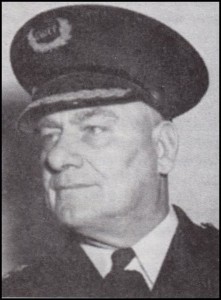 Chief Lee Joseph Smith, (1885 – 1973). Was this man Canada’s greatest Police Chief ever? Most residents will not know his name, or at best, barely remember who Lee Smith was, but by the time you finish reading this four part feature, you will better understand this man’s contributions to the safety and protection of our local society. This is for you Lee. This is your story.
Farm Boy joins The Northwest Mounted Police
Lee was born July 26, 1885 in London, Ontario, but spent most of his boyhood years growing up on the family’s market garden farm in Saltfleet Township, which is the Stoney Creek area of Wentworth County. When Lee was 21 years of age, in 1906, he made a decision that was about to change his life, and not knowing it at the time, this same decision would eventually affect the residents of Burlington, even to this day.
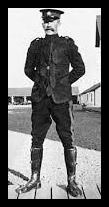 Here is a typical Northwest Mounted Police officer in full dress uniform around 1911. Lee would have worn a “Mountie” uniform exactly like this one, and then climb onto his horse and head out on patrol. His decision was to serve the public in law enforcement. Lee joined the Northwest Mounted Police, where they promptly sent him out west, where Lee patrolled on horseback throughout the wild desolate prairie lands of Alberta, only 1 year into becoming a province.
Later, Lee transferred to the Brandon, Manitoba detachment as a result of his outstanding service, having been promoted to detective. When Police Commissioner Aylesworth Bowen Perry introduced annual training classes, Lee was selected as one of his first instructors. No doubt about it, Lee Smith was a good as it gets; a rising star who undoubtedly was destined to one day become a future Commissioner of the Royal Canadian Mounted Police. Officer Smith while out west had some skirmishes and even took a few bullets, fired upon by local rowdies, but the young man survived, and continued to serve faithfully, and grow as a highly respected police officer.
Boy meets Girl
While posted to the Brandon detachment, Lee met his future wife to be. Her name was Alma Edith Mackenzie a lovely young lady from Woodstock, New Brunswick. Alma was a student studying at the Brandon Baptist College. When Alma was 21 years old, she and Lee tied the knot in Brandon on September 27, 1911. The newly wedded couple lived and worked in Brandon until 1914, when personal tragedy struck back home in Ontario.
Lee, after serving with the Mounties for eight rugged years, felt it best if he resigned, and return to his home area of Hamilton with his bride Alma, after receiving the tragic news his younger sister Annie Katherine, at the age of 26, had died on May 17, 1914, from tuberculosis. Annie had painfully suffered for several years with the dreaded disease. The family was grief stricken. Lee, a compassionate man, felt he had completely let his family down with his long absence from home, and racked with guilt, now wanted to be closer to his family, especially at this very difficult and sad time. Home for good, Lee needed to find work as soon as possible. Then he heard about a possible opening as a constable in Burlington.
Lee Smith finds employment in Burlington as a Night Constable
Lee was hired as a replacement night constable a few weeks after his sister’s death in the spring of 1914. Burlington, at that time, had a population of around 2,000 people during World War 1. Most of the young men from town and the surrounding farms had already gone off to war. If you think about it, if about half the population were children, and ½ of the adults were female, this only leaves 500 adult men in town. Burlington did its part, and we sent 300 over to Europe. Only 200 elderly men remained behind. Who was going to keep us safe? The Town Council had recently gone through a series of unsuccessful attempts to hire other men who did not work out to be the kind of Burlington police officer they wanted patrolling the streets after dark.
Lee Smith’s interview was impressive, and Lee was selected to be their new man of law and order. Lee continued to be exceptional at police work putting his Northwest Mounted Police training to good use. Sometime in 1916 Burlington’s first Chief Constable, Charles Tufgar, 36, who lived on Ontario Street, unexpectedly resigned. Lee Smith, without any hesitation by Town Council was promoted to Burlington’s Chief Constable. Town Council wanted to make sure their “all-star officer” didn’t one day suddenly resign, with ambitions to move up the ladder with another police department. As it was, Lee was not about to leave. The Chief strongly believed in loyalty to the Mayor, the Town Council, and the residents of Burlington he served. The truth was Lee and Alma loved Burlington.
The new Chief delivers his first report to Town Council
It was the duty of the Police Chief to provide the Town Council with an annual update of the activities and concerns of the Police Department during the first week of January. In the Chief’s first report in 1917, he acknowledged the resignation of Chief Charles Tufgar, and he also informed the town’s Council they were without the services of a night constable.
The Chief reported that in 1916 there were 475 cases that went to Court. During that same year, the Chief had found 43 doors were unlocked, and advised those residents to have them secured. The Chief reported that Burlington had 5 fires, and 24 accidents were attended. There were two cases of aggravated assault, 76 overnight lodgers, three house break ins, two charges of abusive language, 14 thefts, four common assaults, 12 disorderly conducts, 11 vagrancy charges, 1 trespassing charge, two stolen horses, 49 warnings issued for small offences, 161 local complaints received and investigated, three charges of residents not having a proper license, five charges of riding a bicycle on the sidewalk, three charges of property damage, 3 cruelty to animal charges, one charge for not having sleigh bells, 286 aliens were registered, seven charges laid for being an alien enemy, 14 charges for drunkenness and breach of the OTA, and seven charges laid for breach of the Motor Vehicle Act.
There were 11 arrests outside of points. The Chief also reported that 29 children had not attended school and the parents had been contacted. A total of $1206.20 in fines was collected. Visitations to the two pool rooms and the moving picture theatre were deemed satisfactory and managed properly. The Chief was referring to Burlington’s new Crystal Theatre located on Brant Street, opposite Ontario Street.
The following year in June 1918, the Crystal Theatre featured the two classic blockbuster silent films, “Birth of a Nation” and “Intolerance”, complete with an in-house orchestra. The Chief concluded by saying, “I highly appreciate the valuable assistance given me by Mayor and Council, also that of the Special Constables and other Town officials during the year.” No doubt about it, the Chief had a very busy year in 1916.
The Chief expands his Police Department & hires more officers
When Lee Smith became Chief Constable, he was responsible for additional duties other than police work. It was also Lee’s job to do all the janitorial duties, such as washing windows, sweeping the floor, cleaning washrooms, and to do minor repairs around the municipal office. Lee was receiving $17.80 each week, and that was after his raise, when he was promoted to Chief. This was thought to be good pay back then.
One day, the Town Council under the leadership of Mayor Maxwell Smith, himself a man of great vision, innovation and entrepreneurship, decided that Lee could use some help as the town tried to modernize, so later that year in 1916 Town Council presented Lee with a telephone for his office, something long overdue, since telephones had been in use since their invention around 1877, almost 40 years earlier.
That wasn’t all that changed for the better. The following year in 1917, affable Bert Dunham was hired as a special constable, and it was decided Bert was to work every other Sunday for $2.00 a day. Bert and his wife Ida who had seven young children were living in a very small house at the corner of Pine and Elizabeth Street; and for the Dunham family, this new source of money was greatly welcomed. Lee knew that Bert needed the extra money and this was his way of helping out when he hired Bert for the job.
One thing about Lee J Smith, he really knew people. Bert was grateful for the work, and he wasn’t going to let the compassionate Chief down. Now, Lee was no longer on call seven days a week, but still came pretty close to around the clock duty. Lee not only worked days, but he also worked nights, and it was decided another constable was needed for the still vacant night shift.
Allan Mitchell, a Scottish born family man who was about 50 years old, also could use another job, after hitting some tough times, and like Bert, Allan could use the extra money to augment his irregular income. The Chief puzzled over how Allan would labour during the day with his various odd jobs, and then still work all night. Regardless of how Allan was going to make it work, he was hired as a night constable by Chief Smith, and this brought about some more badly needed relief for this completely overworked Police Chief.
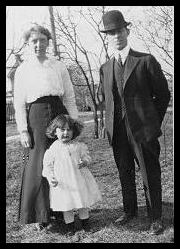 Here is a very dapper Adolphus Smith sporting a fashionable bowler hat, with his wife Susan and daughter Annie around 1918 at their home 2091 Maria Street, near the corner of Martha Street. Doll, as he was known, was the older brother of Chief Smith, and Burlington’s first motorcycle officer. A Police motorcycle, automobile accidents & possible nepotism
The Burlington Police Department grew to 4 officers in late 1919 when Chief Smith hired his older brother Adolphus as a new Burlington police officer. Adolphus was better known by everyone as “Doll”. During World War 1, fighting against Germany, Adolphus was probably not the best name to be known by, so Doll thought this shortened version of his name worked better. Doll Smith, a woodworker by trade was working at a munitions plant in Hamilton during World War 1.
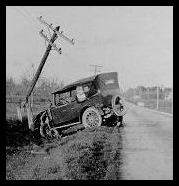 This accident occurred on the Lakeshore when the driver was heading towards Bronte. The impact was severe enough to snap the power line pole. When the war ended, Doll who was married, with a young daughter to raise, was soon to face unemployment and began looking for work. As it turned out, Chief Smith, a man with uncanny vision, had been thinking of a way to patrol the Lakeshore Road area. This road was becoming busier all the time, now that automobiles were becoming more prevalent, and wouldn’t you just know it, automobile accidents were starting to happen, a new phenomenon for the department. The population had increased to close to 2700 people. The population was getting close to a 50% increase over wartime numbers in town. Chief Smith, with virtually no real budget to work with managed to locate a free motorcycle for his department.
The Chief discovered that British World War 1 surplus motorcycles under the Imperial Gift plan, a program set up for all Members of the British Commonwealth to receive some of Britain’s military surplus, on a ruling established by the British Parliament on June 4, 1919 was put into effect. Chief Smith was elated and quickly sent in his application for one slightly used battle scarred motorcycle. When the machine arrived later that year, Constable Smith was assigned as Burlington’s first motorcycle officer.
 Chief Smith secured a war surplus motorcycle similar to this 1918 Matchless, and assigned his brother to patrol the busy Lakeshore Road, the main thoroughfare for automobiles, trucks, carriages, wagons, bicyclists and pedestrians between Toronto and Hamilton from 1919 to 1930. Doll patrolled the Lakeshore Road all the way to Toronto and back. Either Doll was hooked on riding a motorcycle, or he thought Burlington was far bigger than it actually was; whatever the reason, this is what Doll did for a few years. Doll left the department in the late 1920s to ride for the Ontario Highway Patrol, and in 1930 he moved over to the Ontario Provincial Police, when they hired 70 constables to begin their own motorcycle division. Doll was one of the OPP’s first motorcycle officers hired, and remained an OPP motorcycle officer patrolling Highways 8 and 20, right through to the Niagara area, until his retirement in 1950.
What about the nepotism? It wasn’t to be a problem. Not many people in that day could even drive an automobile, and far less could operate a motorcycle. Adolphus Smith already new how to ride, or so he claimed. Doll just happened to be in the right place at the right time. Adolphus Smith passed away in 1975 at 92 years of age.
The Ontario Temperance Act
Just when Lee Smith received his promotion to Chief, Ontario went bone dry in 1916. The Ontario Temperance Act (OTA) was enacted and this new law, designed with good intentions, prohibited alcohol sales. The OTA was in force until the Act was repealed in 1927. Needless to say, the Chief and his three officers were kept busy trying to enforce this unpopular law. Quite possibly, Chief Tufgar may have been provoked into his resignation over opposition to this legislation. The Temperance Act was that controversial.
The story of Burlington’s most famous Chief of Police was told in for parts. The Gazette is re-publishing parts 1 and 4. Links to parts 2 and 3 are linked below.
Part 2
Part 3

 By Mark Gillies By Mark Gillies
January 15, 2015
BURLINGTON, ON
Burlington is using the month of August to celebrate local history. Sometime ago the Gazette published a series of articles by Mark Gillies, a lifelong Burlingtonian. It is appropriate to re-publish the stories about the people who built this city. This is part two of the Spencer Smith story.
Spencer Smith got to Canada as part of the immigration of British children into Canada and Australia. The children were shipped from England by well meaning people but there were some horrific abuses and I believe it is necessary to expand the Spencer Smith story and learn more about how these boys who, without their consent became indentured servants. They were referred to as “Home Children”.
The poem Spencer Smith wrote, it was included in part 1, aches with the longings of a man who missed so much of a natural childhood.
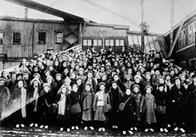 Home children on a dock in St. John NB – waiting for trains to take them east. The concept of Home Children started with honourable intentions; with good people trying to salvage young children from a parent-less home, or incredible poverty. Relocate them to a better life in Canada or Australia, that’s all they had to do. What’s the problem with that?
What made the idea work, was that farmers in Canada and Australia faced a severe labour shortage. They had recently immigrated themselves from Europe, cleared their fields, and grew their crops. Only problem was, who was going to do the harvesting, tend to the fields, feed the animals, and everything else that farmers do in this difficult labour intensive profession?
They didn’t have anybody to help. Governments were perplexed as well; those in Canada and Australia were more than happy to bring in immigrants to open up land and create farms. Sometimes they even gave them free land and supplies, but governments overlooked one part of the equation. Who is going work these large farms? They desperately needed a solution, and quickly.
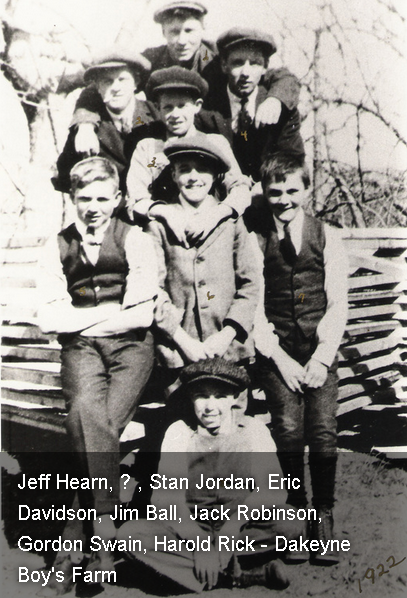 No doubt about it, everyone at the time believed this was a “WIN-WIN” situation. Spencer Smith’s story was a perfect example of one that seemed to have a happy ending. No doubt about it, everyone at the time believed this was a “WIN-WIN” situation. Spencer Smith’s story was a perfect example of one that seemed to have a happy ending.
Featherstone Martindale & Spencer Smith.
Spencer Smith’s sponsor was Featherstone Martindale from Caledonia. If you have ever been to Caledonia, it seems that about every third person you meet has the last name Martindale. They are a fantastic local family and they show up everywhere in Caledonia. Featherstone was born in 1848 in Haldimand County. Featherstone must not have been impressed by his first name, because he always went by the name Fred. He was a good honest man and a hardworking farmer who desperately needed help on his farm. Fred over the years became a father of 8 children and had married 3 times.
The Farmer’s Wife in Spencer’s Poem
In Spencer’s poem, he speaks of the farmer’s wife who influenced him. Spencer was referring to Eliza Mary Shult, who was Fred’s second wife. His first wife Eliza Jane Anderson died in 1881 after giving birth to a daughter named Ann. Fred married Eliza Mary Shult on January 8, 1883, and the new couple proceeded to have 7 children, the first born was Frederick who died in early 1884. Then another son named Featherstone was born in late 1884, and another 5 children were born between 1886 and 1895. In 2 quick years from 1883 to 1885 Eliza had married, and brought along her own small son named Wilfred McBride who was 5 years old from her previous marriage, when her first husband John McBride died from tuberculosis in 1879.
Spencer arrived on the farm May 21st, 1885 when Eliza Mary was just 28 years old. She was quite a busy young lady herself by the time he stepped down from the carriage. This young lady seems quite remarkable to me, since she still had some extra maternal time to still dote on young Spencer, something that helped shape his life.
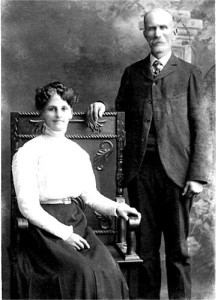 Eliza Mary Shult, the second wife of Featherstone Martindale had a huge influence on Spencer Smith, and he fondly recalls about her in his poem written in 1911. I’m sure old Fred would be quite crusty at times, and probably scared the lads half to death many more times, but Spencer’s poem has a softer edge to it, especially towards Eliza Mary. Eliza Mary died in 1895 from complications of the birth with her last child George Martindale. By this time, young Spencer had already left the Martindale farm. If Spencer actually stayed the full 3 years until he was 18, his servitude would come to an end in January 1888. After the death of Eliza Mary, Fred married a spinster named Margaret Anna Peart in 1907.
The Peart family in Caledonia, which is very large in number, just like the Martindale’s is somehow linked to the Peart family in Burlington, my guess is they are probably cousins. It’s only speculation, but the Jacob Peart farm in Burlington is on the land now occupied by Fortinos, Sears and Ikea, so maybe there was a connection for Spencer Smith to come to Burlington, especially if it was initiated through the Peart families in Caledonia and Burlington. The Peart farm was located directly across Plains Road from the Bell homestead. We’ll never know for sure, but we can at least think about it.
Spencer Smith was quite fortunate and did not face some of the severe hardships that other Home Children experienced. Far too many faced a certain hell of an existence.
The Truth about the British Home Children in Canada
Here’s what really happened to most of the British Home Children.
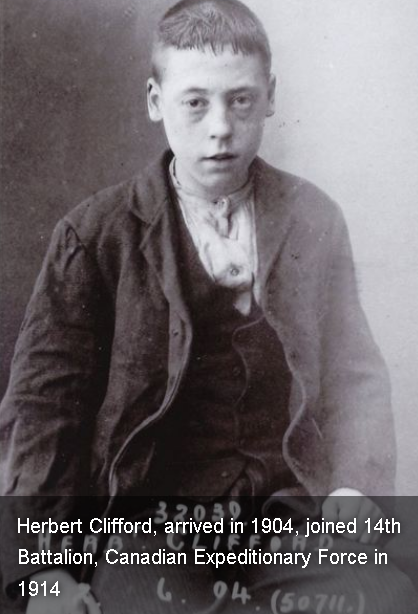 This became an economic issue more than anything else. It was strictly a case of supply and demand. Most of these organizations were faced with a huge demand. They had great difficulty in meeting the demand by farmers and governments in Canada and Australia. It was stated at one time that there were 10 applications for every child. So what were they going to do? The answer was simple. Start rounding up any child who potentially was wayward and lived in the area that was to be scoured for recruits. Overly simplified, absolutely, but not by much. This became an economic issue more than anything else. It was strictly a case of supply and demand. Most of these organizations were faced with a huge demand. They had great difficulty in meeting the demand by farmers and governments in Canada and Australia. It was stated at one time that there were 10 applications for every child. So what were they going to do? The answer was simple. Start rounding up any child who potentially was wayward and lived in the area that was to be scoured for recruits. Overly simplified, absolutely, but not by much.
The fact remains, that the original concept was for orphaned children. The reality was that only 2% were orphans. The rest were children in the wrong place at the wrong time. It’s true that during these times some parents had great economic problems, perhaps they were unemployed or seriously ill, and they had no choice but to hand over their children to a workhouse, or some other care facility until they could get back on their feet and then bring their children home. The truth is, these organizations to help meet the demand, decided to ship them overseas without their parents’ consent. Most of these children had no idea what was happening to them. The parents did not know either. The children never realized that they would never see their family again.
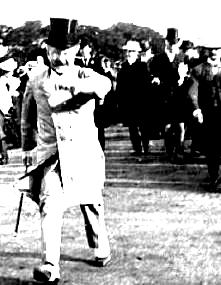 Dr. Thomas Barnardo was a very controversial character, and was responsible for exporting thousands and thousands of British children out of England and relocating them mainly in Australia and Canada. Here he is in 1905 leading the Founder’s Day Parade shortly before his death that same year. The largest organization was run under the management of its controversial founder Dr. Thomas Barnardo. He somehow convinced the Canadian and Australian Governments to take these children. Once that was established, then other organizations like the Shaftesbury Homes, the Salvation Army, churches, and others also jumped on the bandwagon. Probably, none of these add on organizations realized that down the road, this program was going to spiral way out of control, and thousands and thousands of small children were going to be totally exploited in this moneymaking scheme to supply cheap child labour to Canadian and Australian farmers. You can dress it up any way you want, citing testimonial cases that turned out good, reminding people that they were paid a small amount, some orphans were adopted by loving families, but in my opinion, the bare bones reality was: Canada, Australia and England were totally involved in a repulsive child slavery program.
Whatever happened to the other 32 boys who made the trip to Hamilton?
When I researched for information on the other 32 boys that made the trip to Canada with Spencer Smith, only about 2 boys continued to surface on available records. The Flamborough Historical Society has documented one of these Home Children. That boy went on to marriage, become a father and worked as a market garden farmer in Aldershot. He turned out okay.
Spencer Smith turned out okay. The others, they completely disappeared. We know some could have been adopted and had their surnames changed. As an outsider, it is basically impossible to track them. We already know that conditions for some children were so severe that they continually ran away from the farms they were working on, and many were beaten to a pulp when they were caught and returned. We know with documentation as proof that over two thirds of all the British Home children were beaten severely. We know that many of these children were not allowed to become part of the family that was caring for them. 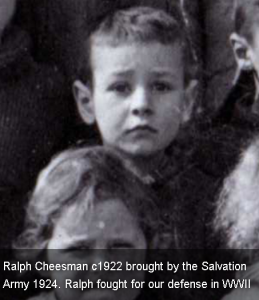 They were forced to live in exclusion on the farmer’s property, and not interact with the farmer’s own children or have any friends of their own. They were not loved or nurtured in any way. We know that they were constantly tormented and bullied by other children at local schools, and even adults participated in this human degradation of these children. We know that many just eventually disappeared. Where you ask? They were forced to live in exclusion on the farmer’s property, and not interact with the farmer’s own children or have any friends of their own. They were not loved or nurtured in any way. We know that they were constantly tormented and bullied by other children at local schools, and even adults participated in this human degradation of these children. We know that many just eventually disappeared. Where you ask?
My guess is some were probably murdered when they were beaten so severely by the farmers, and when authorities came around they just claimed that they ran away. Some children because of horrific living conditions probably became so ill, that they died on the farm, and were quietly buried on the property so as not to draw any suspicion. Others may have committed suicide, and became nothing more than John or Jane Does stashed away in a local morgue, waiting for no one to identify them. Whatever the reason, they’re gone, and we don’t know have explanations. Have a look at this story that appeared in the Saskatoon Star-Phoenix newspaper on April 23, 1930 about a young British Home Child boy named Arthur Godsall who was savagely beaten on a farm in Campbellford by farmer William Albert Hay, age 37.
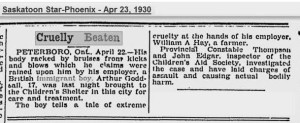 Albert had just arrived from England with many other British Home children and they all disembarked at Halifax from the ship Albertic on March 17, 1930. Albert had just arrived from England with many other British Home children and they all disembarked at Halifax from the ship Albertic on March 17, 1930.
Albert made his way to the Hay’s farm in Campbellford, and less than a month after he arrived he endured this beating and was finally rescued. That’s just one tragic story, there were thousands of stories just like this. One boy was forced to live outside in the dog house with the farm dog. The farmer fed the dog table scraps, and if the dog was full and if by chance there was any dog food left over, it was for the boy to scavenge. Not to mention that this same farmer viciously beat the boy almost daily. Eventually, he was removed from the farm, and as far as I know this farmer did not face any charges. This is unbelievable, but true. This happened in Canada. If you do some basic internet research, you will find these stories and many more.
What’s really disturbing is just how low profile this tragic event in human history was, and just how little we know of it now. But, it is becoming more widely known, and just recently as victims have finally come forward. In Australia for example, the Australian Government were finally brought to their knees by a public outcry after the public learned the truth from these victims, and the government brought forth an apology for their involvement in this hair-brained scheme. Also, the British Government were totally embarrassed by previous governments’ involvement in this tragic situation also came forth with an apology offered by then Prime Minister Gordon Brown. And what about the Canadian Government?
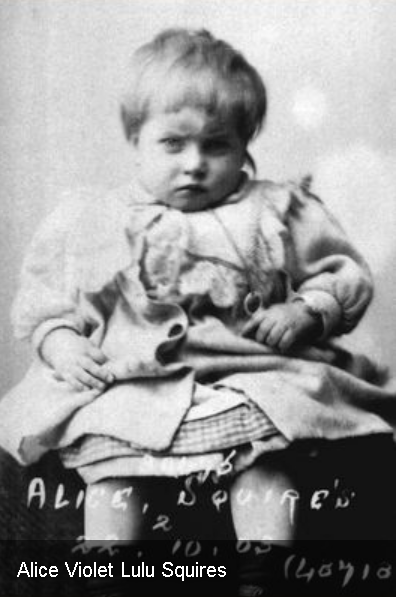 Where do we stand? Sadly, and unfortunately, the Canadian Government has essentially taken the position that this isn’t really a big deal, and no apology is warranted or forthcoming, even though they backed and encouraged this form of child slavery and abuse under the guise of helping disadvantaged children. Personally, I think that Jason Kenney the Cabinet Minister responsible for these remarks was not that well informed on the situation when confronted with the apology question, and consequently brushed it off as unimportant. I encourage you to contact Burlington’s local Federal Member of Parliament, Mr. Mike Wallace, who is a very decent man, and please voice your concern. I would like to think that Mike can champion this cause and help us get this apology from the Canadian Government. It’s long overdue, and it’s the right thing to do. Where do we stand? Sadly, and unfortunately, the Canadian Government has essentially taken the position that this isn’t really a big deal, and no apology is warranted or forthcoming, even though they backed and encouraged this form of child slavery and abuse under the guise of helping disadvantaged children. Personally, I think that Jason Kenney the Cabinet Minister responsible for these remarks was not that well informed on the situation when confronted with the apology question, and consequently brushed it off as unimportant. I encourage you to contact Burlington’s local Federal Member of Parliament, Mr. Mike Wallace, who is a very decent man, and please voice your concern. I would like to think that Mike can champion this cause and help us get this apology from the Canadian Government. It’s long overdue, and it’s the right thing to do.
Here’s how to reach Mike Wallace, Member of Parliament: Burlington Mall Office, 777 Guelph Line, Suite 209, Burlington, Ont. L7R 3N2. T: 905-639-5757 or F: 905-639-6031
House of Commons, East Block, Suite: 115, Ottawa, Ontario, K1A 0A6
T: (613) 995-0881; F: (613) 995-1091 or email, mike.wallace@parl.gc.ca
There is an incredible website on the British Home Children. https://canadianbritishhomechildren.weebly.com/
It tells the whole story of the plight of these exploited children. It will break your heart to read and watch some of the videos made by former Home Children, these men and women who are now elderly, who have finally broken their silence to tell the real story of what happened to them. The website also has a form that can be signed. It is a petition to persuade the Canadian Government to offer an apology to these unfortunate people, many still alive in Canada, and still suffering mental anguish.
Add the website to your “Favourites”. It is quite large and takes a fair bit of time to go through it properly, so you will likely have to go back several times. The website also is constantly updated with more unbelievable stories about this shameful part of our Canadian past.

 By Mark Gillies By Mark Gillies
January 12, 2015
BURLINGTON, ON
Burlington is using the month of August to celebrate local history. Sometime ago the Gazette published a series of articles by Mark Gillies, a lifelong Burlingtonian. It is appropriate to re-publish the stories about the people who built this city. Today we retell the story about the man the lake side park is named after – Spencer Smith.
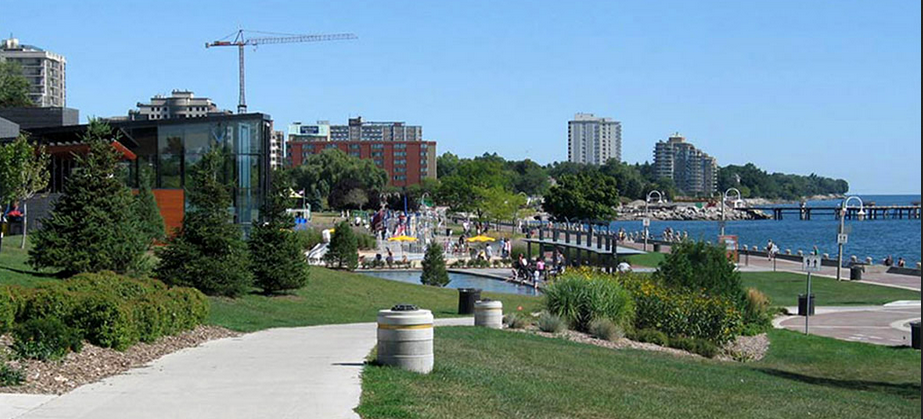 Here is Spencer Smith Park as it looks today; a park enjoyed by thousands of residents annually, all thanks to the vision of a single man. . One of the most recognized names in Burlington is Spencer Smith. We have named Burlington’s most scenic park in his honour. Spencer Smith Park, located on the shores of Lake Ontario, is used for many events that attract thousands of visitors annually.
We know the park; we really don’t know who Spencer Smith was, and just what it was that made him so significant to Burlington?
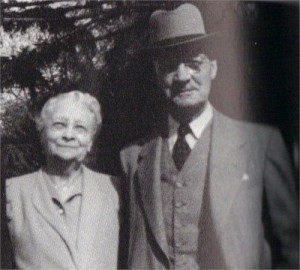 Spencer and Edith Smith a happy couple who enjoyed living and working in Burlington. If you read last week’s column on Edith Hodge, one of Burlington’s earliest settlers, you would have discovered that Spencer Smith was Edith’s son-in-law. Spencer married Edith and William Bell’s youngest daughter Edith Bell.
The Spencer Smith Story
Just how did Spencer Smith end up in Burlington, where did he come from, and what did he accomplish that made his name a Burlington household word?
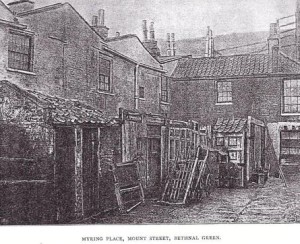 Spencer Smith was born at 7 Mount Street. This illustration shows what housing looked like on Mount Street around the time of Spencer’s birth in 1870. Spencer George Smith was born on January 18, 1870 at 7 Mount Street in Bethnal Green, East London, England to George Spencer Smith 26, and Mary Ann Mears 24. Spencer was the youngest of three children. He had two older sisters, Mary Ann who was born in 1866 and Sarah born in 1868. Spencer’s father worked as a labourer at a local wharf on the Thames River. Mary Ann was also employed, and most likely worked at or near the wharf and was responsible for folding the sails for ships, or as it was referred to in 1870, she was a furl server. Their residence may have been a tri-plex, as two other families lived at the same address. Edward Dwyer, a bricklayer and his wife Isabella, a tailoress, and their 4 children; plus George Scales, a cooper, and his wife Sarah and their 3 children all lived at 7 Mount Street.
Life in Bethnal Green during the 19th Century
Bethnal Green was a very poor neighbourhood, often referred to as a slum area. It was rundown, disease ridden, rat infested, everyone was exposed to raw sewage, the neighbourhood had a gut wrenching bad smell to it, and it was full of sickness, drug addicts, prostitutes, and uncontrollable crime. Bethnal Green was not the best place to raise your family. Bethnal Green was not unlike many other urban communities in England at that time. 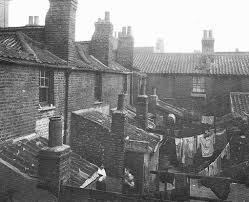
The Industrial Revolution had driven many people from their agricultural backgrounds into the towns and cities looking for work. These areas quickly became overcrowded, and living conditions seriously declined. Times were very bad.
For reasons that we do not know something happened to the Smith family. They basically vanished from the census records for 1880 and everything afterwards.
Death records have not been located proving conclusively that Spencer’s parents or sisters died, or moved elsewhere. Some have claimed that Mary became a widow, and that she had no choice but to give up her children, but this is just hearsay. It could be true. The only person we conclusively know about is Spencer Smith.
For whatever reason, perhaps to escape an imminent transfer to the local workhouse, which was a hideous institution located just down the street at 103 Mount Street. It was a derelict building having been in existence for over 120 year. Perhaps Spencer was to be turned over to an orphanage, we just do not know, but life for Spencer definitely changed. Did you know that workhouses were often the last destination for families that could no longer support their children, and parents were forced to turn them over to the authorities? Even orphanages were overcrowded and poorly run. Many parents died from disease, starvation, alcoholism, murder, suicide, or work related injuries. They left their children destitute, and there was no other recourse, but for these little people to end up in any one of these deplorable institutions.
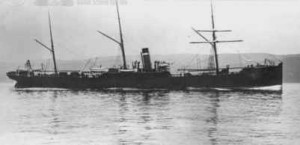 Spencer Smith and 32 other boys were sent to Canada on the SS Corean in May of 1885. This is the actual ship that Spencer made the voyage across the Atlantic Ocean on. Spencer in 1885 at 15 years of age was forced to leave his home and friends, board a steam ship named the SS Corean, along with 32 other boys all about his same age, and set off for Canada. The ship arrived in Montreal on May 14, 1885, and the boys made their way to Hamilton. They travelled on the Grand Trunk Railway, stopping all along the way, including Burlington, and finally on to Hamilton. Who knows, maybe Spencer looked out of the train car window when the boys pulled into the Freeman train station, and thought to himself, “This looks like a nice place. Maybe one day I will live here. Where am I anyway?”
Spencer and the other boys were sent by the Shaftesbury Homes organization based out of London, England. This organization and many others were operating in England, taking on the responsibility of relocating disadvantaged youth to Canada, and also Australia. The largest organization was run by Dr. Thomas Barnardo. It has been written that Spencer Smith was a “Barnardo Boy”, but that information is incorrect. This was a common error made by most people when they referred to the “British Home Children” shipped to Canada. The Barnardo organization was much larger than the other British organizations, the name ended up as generic terminology and just about all were referred to as Barnardo children regardless of the organization that sent them over.
It was believed at this time some British children would have a better life if they were removed from their local environment in their overcrowded communities and sent to Canada and Australia to live and work on farms. The concept was developed mainly for orphans, but over time this evolved into destitute children becoming included as well.
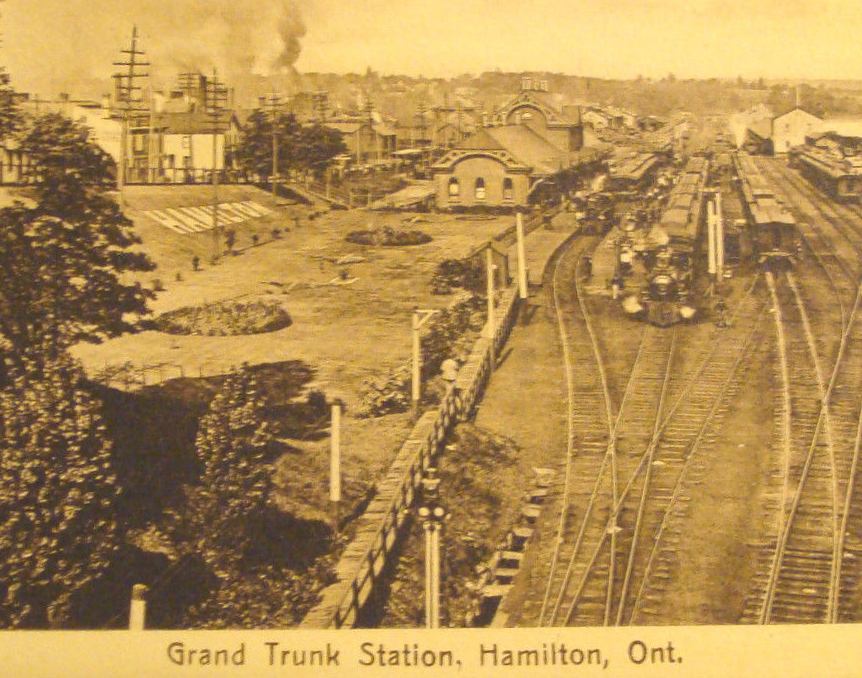 When Spencer arrived by train destined for Hamilton, he disembarked at this Grand Trunk Railway Station located along the southern shores of Burlington Bay. When the Grand Trunk Railway train arrived in Hamilton, the Shaftesbury boys were sent to live temporarily at a location called a “Receiving Home”.
In Hamilton it was called, “The National Children’s Home & Orphanage” which opened in 1884. This home was located on Main Street, in the east end of Hamilton on the grounds of present day Gage Park.
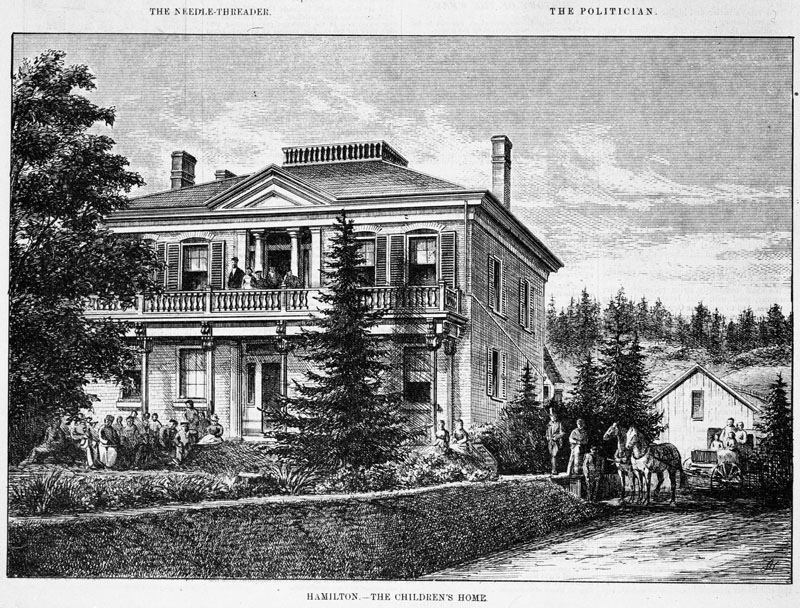 Spencer and the 32 other boys were sent to this “Receiving Home”. It was called the “National Children’s Home & Orphanage”, located on the grounds of present day Gage Park. When the boys arrived, farmers in the Niagara area who had sent in an application to be a sponsor for these children were notified that the children had made it to Hamilton, and they were now ready to be picked up and taken to their new home. Not all children were sponsored before they arrived, it depended on the circumstances that brought them to the “Receiving Home”. In some situations children had to wait for someone to come along and claim them. “The National Children’s Home & Orphanage” over time evolved into Canada’s Children’s Aid Society. Shaftesbury Homes in London, at a later date, became the cornerstone of the London Children’s Aid Society.
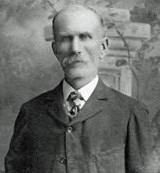 Featherstone Martindale was the farmer from Caledonia who sponsored Spencer Smith taking him back to his farm to begin work as an indentured farm labourer. For Spencer Smith, a farmer named Featherstone Martindale from Caledonia was coming to pick up him and probably a couple more boys too. We know that other boys also went to Caledonia to work on the Martindale farm, but we do not know how many. Most likely it was no more than 2 more boys. They met, and all got to know each other a bit better, and eventually Featherstone, the other boys, and Spencer left “The National Children’s Home & Orphanage”.
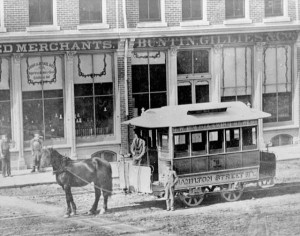 Before the Hamilton Street Railway streetcars became electrified, they were horse drawn. Featherstone Martindale and Spencer Smith and the other boys made their way to the King Street train station on a streetcar just like this one, for the train trip to Caledonia. The group travelled west along King Street in Hamilton on a horse drawn Hamilton Street Railway streetcar to the King Street train station at Ferguson Avenue, embarked on to the train and made the trip to Caledonia. That day was Thursday, May 21, 1885. When they arrived at the Caledonia station, Featherstone, the other boys, and Spencer travelled again for 6 miles, this time in the Martindale’s fancy carriage and on out to the Martindale farm in rural Caledonia.
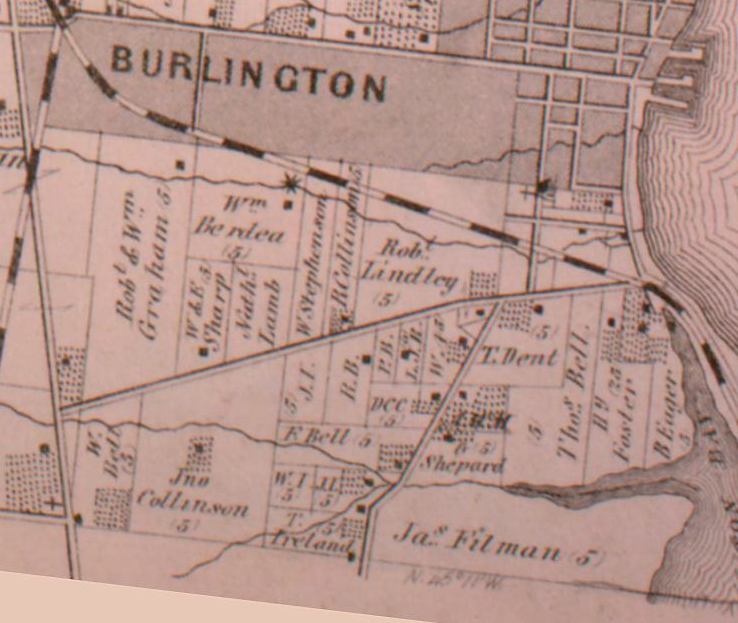 The farms along Maple Avenue provided the country with some of the most fantastic fruit grown anywhere in the world. If you look closely on this map, you can see the Lindley farm where Spencer worked, and also in the lower left corner you can see the William Bell homestead where he worked following his employment with the Lindley family. Spencer Smith’s new Canadian life was about to get underway.
The usual arrangement was to keep a British child on the farm, as indentured servants until they became 18 years of age. These children were to be paid a small wage, fed, clothed, schooled and provide room and board. According to Spencer, he agreed to stay at the Martindale farm for one year. This could be true, or not. We’re not certain if Spencer stayed with the Martindale’s for up to 3 years, or if he went to another farm. We do know that Spencer in 1889 was working as a farm labourer on the Lindley farm in Burlington when he was 19 years old. The Lindley family operated a very successful orchard farm on Maple Avenue. It was located just north of Water Street, now called Lakeshore Road, and it ran north up to about the south side of Mapleview Mall.
The Lindley’s were smart farmers and during the Great Depression, just to stay in business, negotiated a deal with Dominion Stores and supplied the grocery store chain with produce, an agreement so good that it lasted for over 40 years. For many years, the Lindleys and other local farmers hauled their crops by wagon up to the Freeman Train Station, and loaded up the boxcars with their products for transport to markets across Ontario, Canada, England, and even South Africa. The Freeman Station (now under restoration on Fairview Street and in need of more private funding) was the focal point of Burlington’s emerging agricultural market. It was Burlington’s “Window to the World”.
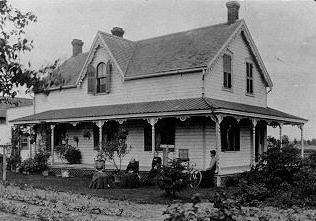 Here’s the Bell Homestead where Spencer Smith worked and met his future wife, Edith Bell. The homestead is still here today, although it looks somewhat different. You could call it, “The Home of the Strawberry Social”. One day, Spencer Smith left the Lindley family farm and moved up Maple Avenue to the William & Edith Bell farm located at the southwest corner of Plains Road and Maple Avenue, and he began working as a farm labourer for the Bell family. It was here at the Bell homestead that Spencer Smith met Edith Bell, the youngest daughter of William and Edith Bell. Spencer courted the farmer’s daughter, and before you knew it, they were engaged and then the young couple married on May 9 1900.
At that time, Maple Avenue went north and more westerly emerging at the Union Burial Ground, the historic pioneer cemetery located in front of the Sears, Fortinos & Ikea stores. It has been reported that Spencer Smith went to work on a farm in Penetang. Again, this is hearsay, and not proven. It is possible, but if Spencer did work on a farm in that area, it would have most likely been after his servitude was completed at the Martindale farm, and before he began work on the Lindley farm by 1889, or Spencer may have left the Lindley farm, went to Penetang and returned to begin working with the Bell family. We’re not certain.
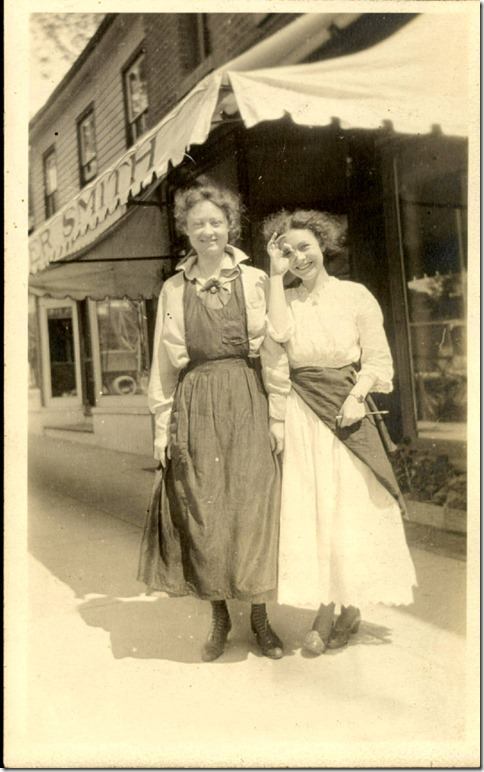 These two young ladies are standing outside Spencer Smith’s green grocery store on Brant Street, just north of Pine Street. The young lass on the right just may be holding a candy stick that was given to her by Spencer Smith. This rare photograph taken around 1914 shows the last part of the name Spencer Smith on the awning’s edge. Many thanks to local genealogist Russell Hunsperger for digging up this picture from his family’s photo archives. Spencer eventually became a green grocer, and opened a store in Toronto, but this did not last long and the couple returned to Burlington, where Spencer opened another green grocer store. This time it was on Brant Street, just 4 doors north of Pine Street, on the east side.
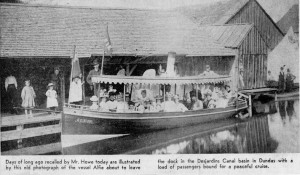 Spencer Smith’s grocery store attracted pleasure boat shoppers just like these passengers on the boat “Alfie” which set out from a dock in Dundas. The store was very successful, and eventually Spencer and Edith became quite affluent. Spencer Smith was a clever marketing man. Whenever children came into his store, they were treated with candy. There were other grocery store competitors in town, but Spencer usually won the day over the other stores. When the children in the neighbourhood persuaded their parents to go shop at Mr. Smith’s store, the parents usually agreed, not quite realizing why the children were so insistent. The other grocers in town probably couldn’t figure out why Spencer Smith’s store continually had so many customers. Spencer and Edith Smith were very good at business, and skilled as retailing entrepreneurs.
In fact, the store was so popular, that passengers travelling on recreational pleasure boats from Hamilton, Dundas, Grimsby, Bronte, Oakville, and other local towns often docked at the wharf located at the foot of Brant Street, just to shop at Spencer Smith’s store. Today, we call this shopping at “Destination stores”.
Spencer was a member of the Burlington Horticultural Society for 36 years, from 1919 up until he died in 1955, where he served as the Society’s President from 1931 – 1936. Other well-known local names served as President when the Society was started for a second time in 1919. The first President was Rev. George W. Tebbs, Rector of St. Luke’s Anglican Church who served in 1919-1920. William Arthur Emory, was Spencer’s brother-in-law and he served in 1925-1926. Paul Fisher served in 1921.
The Fisher family owned the orchard farm where Burlington Mall is located. Fred Ghent served in 1922. Richard Jerome “RJ” Alton served in 1949. The first Burlington Horticultural Society actually started in 1889 by the local market gardeners as more of an agricultural group interested in how to better grow market garden products. The second Society focused more on the beautification of Burlington. It was this latter Society that had the Rose selected as Burlington’s official flower, and to this day, area residents compete for the annual Rose Awards in recognition for residents’ beautiful home gardens.
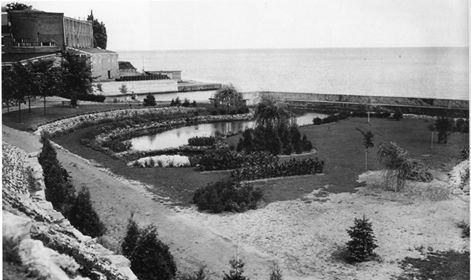 The Lakeside Park was starting to look more like a park. Over the years it continued to develop into a beautiful scenic park. The canning plant can be seen in the upper left as well as the dock that was at the foot of Brant Street. In 1933, Spencer Smith as President embarked on an ambitious project to beautify the land at the foot of Brant Street in Lakeside Park. During the Great Depression the canning plant employees located next door to the park were on strike, and Spencer utilized the strikers to help clean up the new park. It has been reported that Spencer Smith hired these strikers, but more realistically these were probably just volunteers who were quite bored being on strike. There certainly wasn’t much money available at the time, and Spencer was always looking for free assistance, wherever and whenever he could find it. Spencer himself, devoted countless hours of volunteer labour at the park.
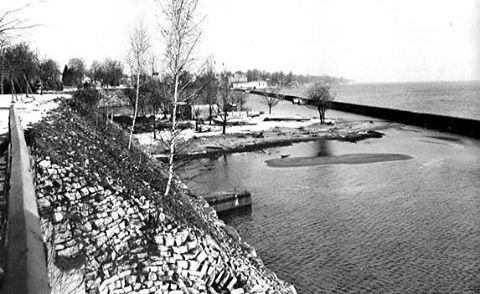 The new Department of Recreation after 1950 decided to add more fill to the water and expand the size of the park. The breakwater is clearly in place. Harold McGrath owned a local trucking company, and Spencer even enticed Harold to drop off any excess loads of rock or topsoil at the park, also probably done at no cost. Spencer had a clear vision for this park, and he was bound and determined to make it happen. The spectacular willow trees growing in Spencer Smith Park are not there by accident. Dorothy Angus the town’s librarian and friend to Spencer, lived on Ontario Street and had willow trees growing on her property. Spencer carefully removed willow tree cuttings and transplanted them to the park. Today, we can see the results of this undertaking. The park was an ongoing project for many years, and in 1942, the Town of Burlington finally recognized Spencer Smith’s accomplishments and named the park “Spencer Park”.
In 1950, the town created a Department of Recreation, and this department took over the management of Spencer Park. One of the first projects undertaken by this new department, was to expand the park with more landfill at the eastern end.
When the Town of Burlington, under the leadership of Mayor Lloyd Berryman, was looking for their own unique Centennial project for 1967, a decision was made that Spencer Park would an ideal choice for an upgrade. The plan was to fill in the entire water area out to the breakwater, and over to the Brant Inn on the far western side, once all of the boats sheltered behind the breakwater were evicted. The Burlington Centennial Committee was created and received the go-ahead for the creation of the new park, and when the park was completed in 1967, they made one very serious error in judgment and attempted to recommend a completely different name for Spencer Park, which was abruptly objected to by The Burlington Horticultural Society and many other concerned local residents who were extremely upset that Burlington’s heritage was once again facing erosion, and quite possibly Spencer Smith’s hard work, commitment, and dedication to his park were about to be permanently removed. The Burlington Centennial Committee reluctantly realized their error, and eventually backed down giving way to a new name, mutually agreed to by everyone on both sides, it was to be called Spencer Smith Park, a name that still stands to this day.
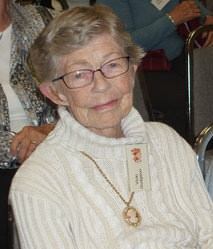 The great grand niece of Spencer Smith was the former Victoria Emery, and after marriage we knew her as Vicki Gudgeon, a local historian and a past President of the Burlington Historical Society personally knew Spencer Smith very well. Spencer didn’t stop at his park. Many of the streetscape trees growing in downtown Burlington were planted by The Burlington Horticultural Society. Burlington didn’t become so scenic and beautiful by itself. Credit should go to those dedicated members of The Burlington Horticultural Society. The property next to Central School was a seedling centre, and the Society grew new plants there which were eventually transplanted throughout Burlington. Spencer Smith’s great grand niece, Vicki Emery Gudgeon, who served as President of the Burlington Historical Society in 1975 -1976 recalled in an interview on the life of Spencer Smith for The Hamilton Spectator in 1989, that all of the trees planted by Spencer Smith and the Horticultural Society on Brant Street were removed when street lights were installed. Vicki stated back then, “I don’t think it was a fair exchange,” I think we can all agree that street lights on a treeless road are not as beautiful as a tree lined road. Vicki had the pleasure to really know her great grand uncle and described him as, “a very kind gentle man, and a gentleman.” She went on to say, “he looked a bit like Charlie Chaplin, because he had the same kind of moustache.”
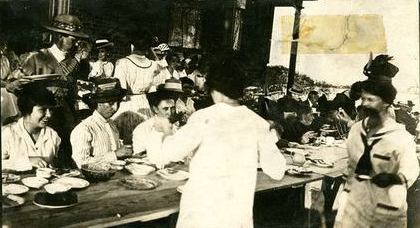 The Strawberry Social was an event that Spencer Smith, his wife Edith, the Bell family, and just about everybody else in Burlington looked forward to every year in town. Here’s Spencer serving up some more treats at the historic Willowbank on King Road. Over the years that Spencer Smith lived in Burlington, things changed, sometimes unexpectantly. Even though Spencer and Edith never had children, they still devoted much of their time to the betterment of Burlington. For example, Spencer and Edith both loved the Strawberry Socials, an event developed by the Bell family, and participated wholeheartedly in making them a rousing annual success in Burlington.
In 1924, after a beautiful 24 year marriage, the blissful happy couple faced a very serious challenge. Edith was not well, and soon became extremely sick. Edith developed pancreatic cancer which eventually spread into her liver, and this lovely, petite, gentle lady died a painful and tragic death on March 21, 1924, in the prime of her life at 54 years of age. The shocked and devastated Spencer buried his beloved Edith in historic Greenwood Cemetery on March 24, 1924. Spencer’s world of new found joy and happiness had ended with pain, and he proceeded to mourn his loss alone, and live a life that seemed to have no purpose.
Spencer continued to operate his grocery store on Brant Street for two more years, he was just putting in time; Then he met a middle aged lady who would become his next wife. She was known as Lillie, but her birth name was Elizabeth Anna Smith. Lillie was born June 7, 1870 in Whitby, Ontario to Thomas Henry Smith and Sarah Smith, a pioneer farm family who lived in the Whitby area for many years. It is not known where and when Spencer met Lillie, but we do know that this was the first marriage for Spencer’s new wife, and it seems a little bit humourous to me that Lillie changed her maiden name from Smith to her new married name Smith. It’s not too often that couples wed each other with the same surname, but it happened here.
Lillie’s new home was to be at 40 Locust Street. I am not certain as to when Spencer purchased this home. We do believe that Spencer and Edith had lived over top of their Brant Street store for a few years.
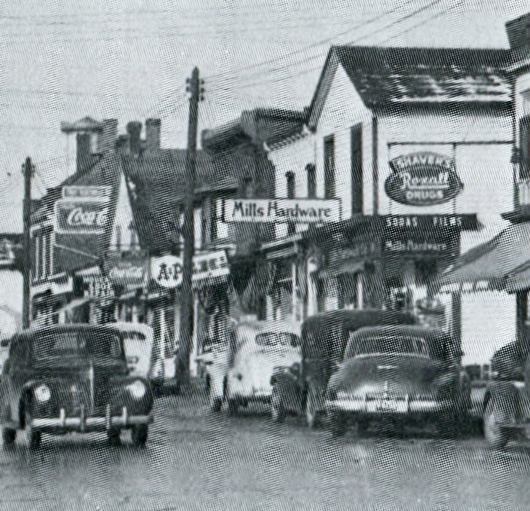 This photograph shows the A & P store that replaced Spencer Smith’s store in the same location. The photograph was taken in 1947 before the A & P moved farther north up Brant Street later that same year. The “modern” looking car in the photo is a 1947 Buick. This vehicle establishes the year of the photograph. It has been reported that Spencer Smith retired from work in 1950 when he would have been 80 years of age. I disagree, but I could be wrong. Although, I do not know exactly when he retired, it was most likely when Spencer was around 65 – 70 years of age in 1935 to 1940. I say that because Spencer Smith sold his store to the A&P Food Store company. A&P came to Burlington around that time, and Spencer was ready to call it a day. A&P took over his location and stayed there until they relocated farther north to a new store on Brant Street which opened in 1947. There are no records that we can locate of Spencer working elsewhere after that time, but he did continue to volunteer his time.
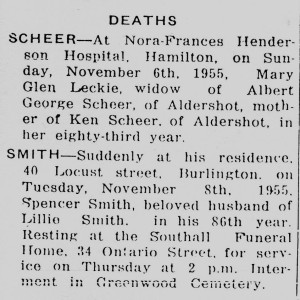 Spencer Smith’s Death Notice appeared in the Burlington Gazette newspaper on November 9, 1955 on page 14, column 3. The town was deeply saddened to hear of the passing of one of Burlington’s greatest citizens. 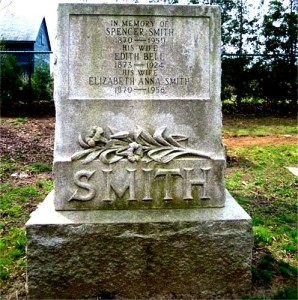 Spencer Smith, his first wife Edith, and his second wife Lillie are buried in historic Greenwood Cemetery. On November 8, 1955 Spencer Smith peacefully passed away at his residence at 40 Locust Street. He was buried alongside his cherished wife Edith in historic Greenwood Cemetery. The following year in 1956, Lillie, Spencer’s second wife passed away at 85 years of age, and was interred with Spencer and Edith in Greenwood Cemetery.
The full life and times of Spencer Smith was now over, but not forgotten.
Spencer Smith left us with a poem that he composed in 1911. He called it “Reminiscences”. In poetic phrasing Spencer captures some of his memories that changed his life.
Reminiscences
‘Twas six and twenty years ago,
And perhaps a little bit more,
When I, a lad of fifteen years,
Lit on this fair Canadian Shore.
Fate led the way to Hamilton,
And there a man I met,
Who said a likely boy to do the chores
I certainly must get.
I don’t think I looked likely,
For the voyage had been rough,
And leaving home and friends behind,
I felt most mighty tough.
But the farmer thought I’d suit him,
If I’d try and do what’s fair;
So we came to an agreement,
And I hired for a year.
We boarded the train at King Street-
I’ll never forget that day;
It was in the spring of eighty-five,
On the twenty-first of May.
My thoughts were busy all the way,
On the new life I was now to begin;
To me the prospect seemed gloomy,
And my future loomed very dim.
We arrived at Caledonia,
And the farmer’s old bay mare
Soon took us down the river road
To the farm, six miles from there.
The buggy we rode in was classy,
The roads none I’d seen could compare-
We took so much on the wheels as we went
It’s a wonder there’s any there.
My boy courage rose as I entered the house,
And I saw the farmer’s wife.
I’ll never forget her as long as I live;
And bless her all my life.
I had my tea and went to bed,
And slept as sound as a trout.
And the first thing I heard in the morning
Was: “Come, boys, it’s time to get out.”
I put in that day in a hazy way;
For a lonesome boy was I,
And as I drove the cows to the fields
I heaved many a deep, deep sigh.
Each day was filled with surprises,
And, Oh, the mistakes I did make!
Were the things I broke put together
They’d be worth all the wages I’d take.
The farmer was often impatient;
And often discouraged was I,
But one thing that kept up my courage
Was the farmer’s good wife and her pie.
The cows and the horses, the sheep and the pigs,
Were ever a worry and care;
But since I have left them I think of them still,
And in my dreams fancy I’m there.
The lessons I learned on the farm are worth more
To me than mere dollars and cents;
And if I were privileged to start over again,
It’s life on the farm I’d commence.
The farmer’s wife has gone to her rest,
But her influence lives in me still:-
She helped lift the load along life’s rough road,
And save me a start up the hill.

Part two of the Spencer Smith story will be published later this week.
My next article will be on Police Chief Lee J Smith, Burlington’s longest serving Chief. He was a no nonsense, tough as nails, compassionate man who faithfully served our community from 1916 to 1956. He saw it all over those 40 colourful years.

 By Mark Gillies By Mark Gillies
February 2, 2015
BURLINGTON, ON
Burlington is using the month of August to celebrate local history. Sometime ago the Gazette published a series of articles by Mark Gillies, a lifelong Burlingtonian. It is appropriate to re-publish the stories about the people who built this city.
Would you like to know who I think was one of Burlington’s great business leaders of the early 20th century? Many great people who lived here before us, sacrificed much to help shape Burlington; in order for us to benefit from our beautiful surroundings today. As a local society, we have in far too many cases, turned our backs on these great citizens of Burlington. This is a real shame, and it doesn’t have to be this way.
As in my previous articles, most of the people I write about will be names that you do not recognize, and are now reading for the first time. These outstanding citizens of Burlington accomplished much locally, but have never been properly recognized. One such person is Henry “Harry” Lorimer.
Harry Lorimer moves up the ladder with The Grand Trunk Railway
Harry was born on the family farm in Norfolk County, February 8, 1861. By 1891, Harry left the family business and pursued a career with the Grand Trunk Railway in Norfolk County. Harry’s first job was a telegraph operator, then he became a Railway Agent assigned to a station in Norfolk County, where he perfected his skills, before receiving a promotion that was about to relocate Harry and his family to a more fast paced location, the Burlington Junction Station in Freeman.
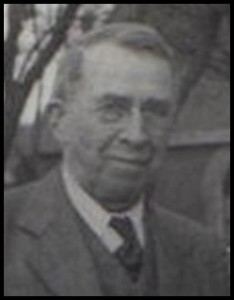 Harry Lorimer was the Burlington Junction Station Master in 1906 when it opened after fire destroyed the previous station in 1904. By 1897, Harry, his wife Seba, and daughter Gertrude were living in Freeman, and Harry was working as the Grand Trunk Railway Agent. It was very prestigious to be assigned as a Railway Agent to a Junction station. There was so much activity all of the time. Burlington Junction had double track lines running from Montreal right through to Chicago. Trains were travelling both ways. Then, the Grand Trunk Railway had another track running from the Niagara Region, across the Beach, through town, and up to Freeman where it crossed over the double tracks, continuing up to Georgetown, and then up to Allandale.
Burlington Junction also had freight warehouses, which were always busy with boxcars being loaded or unloaded. The responsibility and stress levels were extremely high for Harry Lorimer. The complicated schedules and logistics were unbelievable. Harry was lucky to have a telephone, some needed high tech assistance. The Station Master’s number was easy to remember. Who could forget “2”? Harry was the only Station Master for two different Freeman Stations. One burnt to the ground in 1904, and was replaced by another GTR station in 1906.
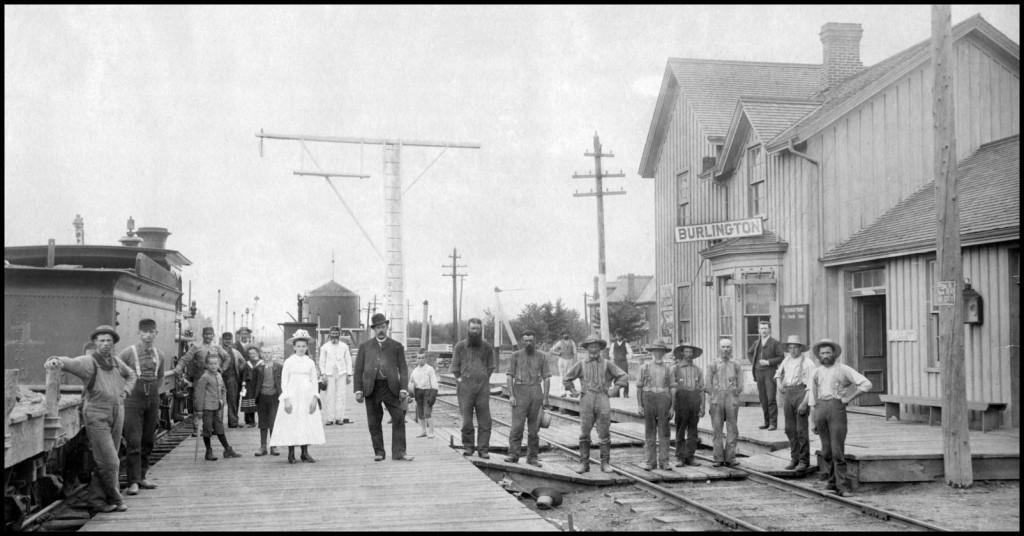 After a fire destroyed the original Great Western Railway train station in 1883, this second station was built by the Grand Trunk Railway, which also succumbed to a fire and was destroyed in 1904. Harry Lorimer was Station Master for both railway stations.  This is the historic 1906 Grand Trunk Railway Station photographed just after it had been built. The GTR identified the station as “Burlington Junction”. Our historic station was one of the busiest Junction stations in all of Canada. Now, thanks to the financial generosity of local citizens and businesses, this 109 year old historic building, owned by the City of Burlington, is in the process of restoration and has been permanently relocated to Fairview Street, west of Brant Street. The city owned 1906 historic station is now under restoration in a new location on Fairview Street, solely at the expense of private citizens and local businesses, who have come forward to save the station from demolition, as recommended by The City of Burlington. The City of Burlington at one time was to receive close to $1,000,000 in stimulus money to finance the relocation and restoration, but Burlington City Council, several years ago, were unsuccessful in agreement on a new suitable location. Subsequently the City of Burlington lost access to all of this stimulus money. Then, their solution to solve the problem on what to do with this magnificent old building, was a decision to have our heritage rich Freeman Station demolished, despite this being one of Burlington’s most historic buildings, and a huge part of Burlington’s colourful heritage. The citizens of Burlington were outraged at their thinking. Some on City Council still continued to fight to save our beloved Freeman Station and have been officially recognized for their outstanding efforts by the citizen organization, Friends of Freeman Station.
The Station Master was a highly respected citizen
The Station Master or Railway Agent in any town with a railway station was always a very influential and prominent citizen in their community. Railway Agents were very well respected, much like the clergy, police officers, doctors or lawyers. One of the reasons for this high level of respect was due to the fact that new families moving to Canada from Europe, arrived on the scene, and knew no one, often standing on the railway platform, suitcases in hand, and not knowing what to do, or where to go. The first person they saw and who offered to help them was the local Railway Agent. From meeting their first friend in Canada, new arrivals, one day, responded in kind. Often times, throughout Canada, the town’s highly respected Railway Agent also became the local Reeve or Mayor.
In 1901, Harry and his family were well entrenched into Burlington’s local community. Some of their good friends and neighbours were John Thomas Tuck and his family, plus the Ghent family, two very prominent local families. We’re all familiar with John T Tuck School on Spruce Avenue, and we all know where Ghent Avenue is located in Burlington. These two families have been recognized locally, but not so for Harry Lorimer.
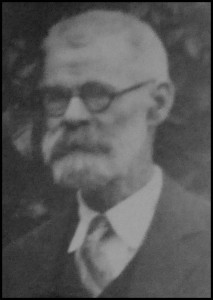 James S. Allen was the proprietor of Allen’s Hardware at the time it was sold to Harry Lorimer and Gordon Colton in 1912. James S. Allen was the nephew of George Allen, the previous owner, who then moved on to build prestigious homes in the core area of Burlington. James S. Allen, later became the Mayor of Burlington from 1925-1928. Harry Lorimer changes careers and Burlington wins again
In 1912, Harry, who was just 51 years old, made a career change. He became a hardware merchant and bought into an established business with his son-in-law, Gordon Colton. Together, they bought the hardware store, Allen’s Hardware, from James S. Allen, who at one time served as Mayor from 1925-1928. James Allen had previously purchased the business from his uncle George Allen in 1901. George had become Burlington’s most prominent home builder at the time, and was responsible for the building of many of Burlington’s historic homes in the downtown core, which was referred to as the Wellington Park area. The former Allen’s Hardware, was now called Colton & Lorimer Hardware store, and was located at the northeast corner of Brant Street and Pine Street. Their retail neighbour 2 doors north, was Spencer Smith’s green grocery store. I wrote about the remarkable Spencer Smith and his accomplishments in my article on January 12th. The hardware store, from the same location, operated as a thriving business well into the 1970s when it was owned by Keith Dale from Aldershot, and Keith operated it as Dale’s Hardware. Keith Dale purchased the store from the Mills family who had operated it as Mills Hardware, after they purchased it from Harry Lorimer.
 The Allen’s Hardware name was removed and the Colton & Lorimer name was added to the outside of the building in 1912. The historic building was located at the northeast corner of Pine & Brant Streets. This historic building met a fate all too familiar in Burlington, and was demolished. The retailing skills of Harry and Gordon were outstanding, as they both realized Burlington was growing quickly. Harry and Gordon understood that they needed to supply all of the local market gardeners with proper farm supplies, implements, and chemicals, plus they were also aware that new housing starts, and new building construction would provide incremental retail sales. To have everything in stock for both farmers and homeowners, and at the same time was a massive retailing nightmare. Big “Box stores” were not in Burlington yet, close to 100 years into the future, but Harry and Gordon knew exactly what would sell and what to stock in their store. Burlington was their market, and their shrewd retailing skills made Harry and Gordon very successful businessmen.
The Colton & Lorimer Hardware store was extremely successful, undoubtedly the most successful retail location on Brant Street, and most residents in Burlington shopped there. If you were lucky enough to have a telephone in Burlington, you could call Colton & Lorimer. Their number was “9”. If Colton & Lorimer didn’t have what you wanted, then you really didn’t need it. Colton & Lorimer had fine-tuned hardware retailing to a science.
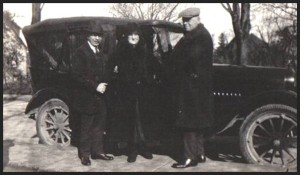 Harry Lorimer proved to be a superior retailer, and as a result the Lorimer’s attained substantial affluence. Along with the purchase of a custom made house, built by Burlington’s most prominent builder, George Allen; Harry & Seba also acquired a luxurious automobile and were driven about town by Bob, their chauffeur. With hard work, comes the spoils, Burlington’s on a roll
Harry and Seba finally decided to purchase a new home. They also decided to buy an automobile, and hire a chauffeur to drive them around. The hardware business was doing that well. The beautiful home they chose was built by Burlington’s most prominent home builder George Allen. Many of George Allen’s beautiful homes have now been designated as historical. The Lorimer residence was built in 1914 on a lot to the north of George Allen’s own historic house at 1391 Ontario Street. George Allen did not disappoint the Lorimer family. Their new home was stunning. The historic Lorimer family is at 504 Burlington Avenue, and the house just had its 100th birthday.
 George Allen built this beautiful home for the Lorimer family, and they moved here in 1914. The house at one time was recognized as historical, but in 2013 it was removed from the Registry by the City of Burlington for alleged lack of historical significance. City of Burlington insults Harry Lorimer’s legacy 50 years later
This beautiful home was lived in by the prominent Lorimer family for 50 years, from 1914 until 1964, and at one time was recognized as historical and added to the Municipal Register of Cultural Heritage Resources, then was officially removed from the Register in 2013 for what was said the be a lack of historical, architectural, or contextual value. (I know what you’re thinking, I’m not making this up, it really happened). The City of Burlington defends its heritage reasoning found on their website as follows:
What is Heritage Conservation?
“Heritage conservation involves identifying, protecting and promoting the elements that our society values. Heritage conservation has traditionally been associated with protecting the physical or built environment (buildings, structures, landscapes, facts etc.). More recently, the term has also come to be associated with safeguarding the non-physical associations between people and a place (associations linked to use, meanings and cultural or spiritual values).”Taken from Parks Canada Standards and Guidelines for the Conservation of Historic Places in Canada
Why is Conservation Planning Important?
The conservation of built heritage is an integral part of the land use planning process at the City of Burlington. It entails planning for the identification, protection and promotion of the heritage resources that our community values. Burlington’s heritage is a living legacy that helps us understand our past, provides us context for the present and influences our future.
Why Conserve our Heritage?
The conservation of cultural and heritage properties is vital to a community’s overall cultural and economic development and it can enrich our lives, inspire us and create a sense of community that can sustain generations. The Heritage planning process in Burlington is overseen by staff in consultation with the Heritage Burlington Committee.
The Passing of Harry Lorimer and his Family
Harry lived to be 99 years old, and passed away peacefully in 1960. His beloved wife Seba died 10 years earlier at 85 years of age in 1950. Gertrude, their daughter died at 76 years of age in 1964, and her husband Gordon tragically died at 31 years of age in 1918 as a result of the great influenza epidemic. They are all buried together as family, in Aldershot’s historic Greenwood Cemetery. All residents of Burlington owe a huge debt of gratitude to the Lorimer and Colton families. These two dynamic families were true genuine pillars of the community and did far more than their fair share in helping to build, shape and drive Burlington’s economic engine so efficiently into the 20th century
Plan to Attend Heritage Days
On Saturday, February 7th at Burlington Central Library, Heritage Days will be in full swing with many wonderful displays of Burlington’s local heritage featured for the public to view. Plan to take the children or grandchildren. It’s free to everyone. There will also be several guest speakers throughout the event. Heritage Days will be from 10:00 AM to 3:30 PM. One display you will not want to miss, will be the Burlington Junction Train Station 1:24 scale model. This beautiful model was handcrafted by Burlington resident, Mr. Bob Chambers. Thanks to Bob’s talents, you will get to see what life was like in 1906 when the historic train station opened, and Harry Lorimer was its first Station Master.
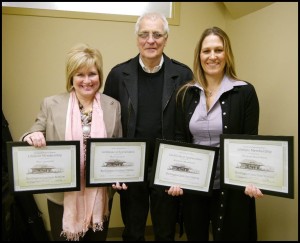 Councillors Marianne Meed Ward and Blair Lancaster, both heritage preservation advocates were recognized by the citizen group “Friends of Freeman Station” for their perseverance and leadership in convincing the others on City Council that the Freeman Station was worth saving. 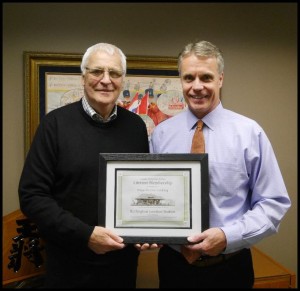 Mayor Rick Goldring was recognized by “Friends of Freeman Station” for his personal involvement in helping to save the Freeman Station from demolition, as recommended by the City of Burlington. Mayor Goldring received a Lifetime Membership to Friends of Freeman Station from Brian Aasgaard, President of Friends of Freeman Station. The Friends of Freeman Station will be there to answer all of your questions. Please plan to donate generously to help these exceptional volunteers complete the restoration of this magnificent historical building, something the City of Burlington could not accomplish. Without private financial support, this Burlington Junction restoration cannot be completed. There is no local, provincial, or federal government funding.
My next article on February 9th will be on the Burlington Junction Station, or as it is so often called, the Freeman Station. Find out why I believe Burlington Junction Station is Burlington’s most historical building, and why we need to make sure this part of our local heritage is preserved for future generations.
Related article:
What the Freeman Station really meant to the growth of the city; it was the key link in the transition of the city

 By Pepper Parr By Pepper Parr
July 30th, 2021
BURLINGTON, ON
 Andrea Grebenc: a very expressive trustee who grew to become the Chair Andrea Grebenc, Chair of the Halton District School Board Trustees, has become the go-to person for much of the media when it comes to comments on what the provincial government is doing about opening schools in September.
At this point teachers are back in the classroom on September 1; the students start back on September 7th.
Grebenc said she really does not know what the province plans – other than that the Premier will be making an announcement immediately after the holiday.
In a CBC radio broadcast Grebenc said she believed it was vital that the Directors of Education be at the table so they can give some immediate feedback on what the consequences and impacts are going to be to any of the decisions made.
What if they decide to go for fewer students in each classrooms – that means the Boards of Education have to scramble to get the teachers that will be needed in place.
She believes that if the front line education people had been at the table students would not have lost as much time last year.
 Grebenc and Director of Education (now retired) Stuart Miller had a very good working relationship. Both listened to each other and crafted a collaborative approach to the challenges. Everyone benefited. The switch into virtual teaching had a huge impact on everyone said Grebenc. There were teachers who found it very difficult to make the switch. Halton’s Director of Education said that there were some teachers who decided they could no longer teach adding that everyone in the system believe that the best education takes place in a classroom in a school.
There is a place for virtual learning but it is not as replacement.
Grebenc says we are now in a vacuum with information coming out in dribs and drabs. “I am at the point where I don’t know what I don’t know”. It is very tough to do what has to be done without a clear idea of what the rules are going to be.
“We are running out of time” she said. “All of our senior people usually take some vacation in the summer – they have certainly earned it – but they are holding back until they are certain as to what the playing field is going to be like come September.”
The Board isn’t broke but they have had to dip into their reserves for the past two years. “Those funds were set aside for a specific purpose, said Grebenc. “We are hoping that the province will make good on the money we had to take out of the reserve accounts.”
On August 11th last year the province changed all the rules and we had to scramble to be ready. “We don’t want a repeat of last school year.”
Halton is also in a situation where a new Director of Education starts August 6th. Stuart Miller retired at the end of July after 35 years as an educator starting in a classroom and growing through every rung of the ladder that led him to the top job.
 Newly appointed Director of Education for the Halton District School Board – Curtis Ennis Chair Grebenc and her vice chair will be meeting with Curtis Ennis right after the holidays to brief him on the status of the multi-year plan the Board has in place and talking through the goal setting the trustees will put in place for the new Director.
“We have no idea what the extracurricular requirement is going to be; will the rules be the same for every District School Board? Grebenc takes the view that the trustees have the pulse of the community and can bring Curtis Ennis onside quite quickly.
The Multi Year plan is reviewed and revised every year – the time line for that will change a bit while Curtis Ennis gets up to speed.
Grebenc believes the trustees now have a much more collaborative working relationship with staff. It wasn’t always that way.
Staff are now much more in touch with the trustees and there are conversations and some cross pollination in terms of ideas.
They are working much better and differently than they did in the past.

 By Staff By Staff
July 28, 2021
BURLINGTON, ON
In a release to media Halton Region reports on the tremendous success they have achieved vaccinating residents at its community clinics.
Halton’s vaccination rate for residents 12 years and older continues to exceed the Provincial average. With more Halton residents now fully vaccinated, Halton Region will begin consolidating its community clinics in August to focus on targeted community outreach and school-based immunization programs.
Effective August 16, the COVID-19 vaccination clinics at Joseph Brant Hospital (JBH) and Oakville Trafalgar Memorial Hospital (OTMH) will be closed. This decision was made in collaboration with Joseph Brant Hospital and Halton Healthcare.
 Halton Regional Chair Gary Carr. “We have reached a significant milestone in our COVID-19 vaccine rollout, with 81 per cent of residents having received one dose and 65 per cent of residents fully vaccinated,” said “Thanks to the commitment of Halton residents to get vaccinated and the tremendous work of our clinic staff. Over 250,000 doses of COVID-19 vaccine have been administered at our hospital clinics, and I am extremely grateful for our hospital partners for their dedication and contributions to the vaccine rollout over the past several months to get us to this pivotal point.”
Residents who had vaccine appointments scheduled at Joseph Brant Hospital and Oakville Trafalgar Memorial Hospital on or after August 16 are being notified that their appointments will be cancelled, with options to reschedule at another Halton clinic, pharmacy or primary care provider.
Halton Region is working on a plan to also begin consolidating community vaccination clinics by the end of the summer. Coupled with expanded access to COVID-19 vaccines through pharmacy and primary care offices, Halton Region Public Health will continue to deliver and expand its targeted community outreach to support anyone who may experience barriers to vaccination and ensure no one is left behind.
In addition, several clinic locations will transition to immunization clinics that will offer non-COVID vaccines to students in Grade 7, 8 and 9 as part of the school immunization program. This will provide Halton with an opportunity to catch-up eligible students who were not able to get vaccinated with these important vaccines due to the pandemic.
 Dr. Hamidah Meghani, Halton Region Medical Officer of Health. “I am grateful for our hospital partners who have been instrumental in the Halton vaccine rollout and provided high quality care to our community throughout the COVID-19 pandemic,” said Dr. Hamidah Meghani, Halton Region Medical Officer of Health. “While this is an important step to return to normal, it’s critical that more residents get fully vaccinated as soon as possible to protect themselves and our community. Each and every dose counts, and getting your second dose will give you better protection against COVID-19 and the Delta variant. #RollUpYourSleevesHalton and let’s make it a two dose summer so we can avoid a fourth wave in the Fall.”
 “It was a privilege to be the first Vaccination Centre in Halton Region and to be part of the largest immunization rollout in a generation,” said Denise Hardenne, President & CEO, Halton Healthcare. “By August 15 we expect to have administered 200,000 vaccines at the OTMH Vaccination Centre. With community clinics now well established and the demand for vaccines decreasing, the closing of hospital vaccination centres will provide us with the opportunity to focus on our recovery plan. I couldn’t be more proud of the efforts of our staff and physicians for their dedication and tremendous efforts in the fight against COVID-19.” “It was a privilege to be the first Vaccination Centre in Halton Region and to be part of the largest immunization rollout in a generation,” said Denise Hardenne, President & CEO, Halton Healthcare. “By August 15 we expect to have administered 200,000 vaccines at the OTMH Vaccination Centre. With community clinics now well established and the demand for vaccines decreasing, the closing of hospital vaccination centres will provide us with the opportunity to focus on our recovery plan. I couldn’t be more proud of the efforts of our staff and physicians for their dedication and tremendous efforts in the fight against COVID-19.”
“Since opening in March, over 58,000 vaccinations were administered at the Joseph Brant Hospital vaccination clinic,” said Eric Vandewall, President and CEO of Joseph Brant Hospital. “I would like to thank our hard-working staff, physicians and volunteers who helped make this clinic a success, and for their ongoing commitment to meet the needs of our community during the pandemic. I also would like to thank the residents of Halton Region for their overwhelming support of our clinic, our people and our hospital – we are so grateful and honoured by your kind and encouraging words, emails, social media posts, lawn signs and letters.”
Important information & instructions
• Effective August 16, vaccination clinics at Joseph Brant Hospital and Oakville Trafalgar Memorial Hospital will be closed. Residents 12 years of age and older can reschedule their appointments at any of Halton’s seven Community Vaccination Clinics through the online booking system.
o Bookings for Halton residents are not available through the Provincial booking system; residents who access the Provincial booking system will be redirected back to Halton’s system.
o Walk-in appointments are currently available at some Halton Region Vaccination Clinics on a first come, first served basis and dependent on supply. Learn more about current walk-in locations and times.
o To maintain physical distancing and safety measures, please arrive 10 minutes prior to your appointment (not earlier) and remember to wear a mask. Please note: you will be required to bring proof of age to your appointment, and are asked to complete a wellness check before attending a clinic, using Halton’s COVID-19 Vaccine Clinic Screening Tool.
o Residents are asked to attend their appointments alone if possible in order to limit the amount of individuals in our clinics and maintain adequate physical distancing. You may bring one support person, if required (for example, a caregiver or interpreter).
o There are also more than 100 pharmacies in Halton are offering walk-in or booked appointments and select primary care offices offering booked appointments for the COVID-19 vaccine. Please contact the pharmacy or primary care office directly to learn more.
• The quickest and easiest way to schedule or reschedule an appointment is online. Residents who require booking support can also call 311.
o Residents should cancel their appointments as soon as possible if they find earlier appointments through a pharmacy. By cancelling your appointment, this ensures that someone else who is eligible can get the vaccine.
• Residents have the option to book same-day (“last minute”) vaccine appointments through our online booking system. These appointments will become available when there are last minute cancellations at a vaccination clinic. This option is only available to those who are currently eligible and residents must arrive at the selected clinic within 45 minutes of booking.
• Residents who need assistance with transportation (if transportation is a barrier to getting to the appointment) can contact 311. Halton Region continues to offer transportation services to and from appointments for residents who require support, free of charge.
The infection numbers for the Region and Burlington are manageable. Of the 46 active cases in the Region as of July 28th 22 were in Burlington.
The concern at this point is the anti-vaxers. There is work to be done on that cohort. The solution for those of us who understand the need for vaccinations to continually correct the information that is out there.

 By Staff By Staff
July 20th, 2021
BURLINGTON, ON
The air quality in Burlington right now is the THIRD WORST in the World!
What? How could that be? And who made the statement and what evidence do they have?
The World Health Organization claims our air quality is six times worse than the accepted rate.
The cause is mostly due to the 100 fires burning in Ontario.
 
Alan Harrington, an inveterate Gazette reader brought this to our attention and suggests people may want to put those masks they may have put away backon.

 By Staff By Staff
July 11th, 2021
BURLINGTON, ON
 Trustees Margo Shuttleworth and Tracy Ehl Harris delegating virtually before a city Standing Committee. Halton District School Board trustees Margo Shuttleworth and Tracy Ehl Harris delegated before a city Standing Committee earlier this week to explain what the Board of Education was doing in the matter of renaming a school.
We have heard from many voices in the community and had many conversations which culminated with formal requests from community members, including those who are survivors of residential schools to consider a change in name of our school on Woodview Drive.
Of course, we have also heard from some who feel we are discounting the positive contributions of Egerton Ryerson to the Canadian education system. He did indeed create school boards, making textbooks more uniform, and making education free. He also advocated for the separation of Church and State within education….. apart from the education for Indigenous children.
For Indigenous students he drafted a Ryerson Industrial Schools Report which supports the creation of industrial schools. These schools have been called manual labour schools, industrial schools, boarding schools, and residential schools. They included religious instruction which Ryerson felt necessary to assimilate and civilize Indigenous children, .
 Instruction for the most part was delivered by Clergy We need to be accountable to the legacy that Ryerson also left behind and the trauma and hurt it causes our students and their families to feel. We must be compassionate to the hurt and trauma that has been part of his legacy.
I am going to read for you an overview of The Ryerson Experiment compiled by Nishnawbe Aski Nation ( Nishnawbe Aski Nation Indian Residential Schools in Ontario, 2005 ). This group represents 49 First Nation communities within northern Ontario with a population of membership (on and off reserve) estimated around 45,000 people.
In 1845, a report to the Legislative Assembly recommended that industrial boarding schools be adopted for the education of Indian children. In 1847, Dr. Egerton Ryerson, the Chief Superintendent of Education for Upper Canada (Ontario) suggested a method of establishing and conducting the industrial schools for the benefit of Indian children.
Their purpose should be to “give a plain English education adapted to the working farmer and mechanic” and in addition “agriculture, kitchen-gardening and mechanics so far as mechanics is connected with the making and repairing the most useful agricultural implements”. To attain their objective, it would be necessary for the students to reside together, with adequate provision being made for their domestic and religious education. Dr. Ryerson especially deemed the latter essential. “With him (the Indian) nothing can be done to improve and elevate his character and condition without the aid of religious feeling”.
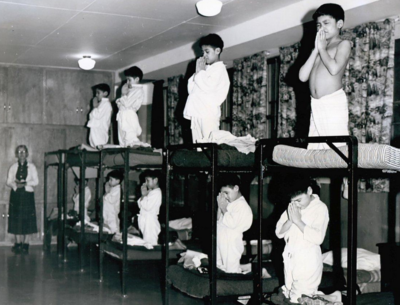 Spiritual guidance was part of the curriculum at the residential schools. For this reason he insisted that the animating and controlling spirit of each Industrial School “should be a joint effort of the Government and of the religious organization concerned. Decisions on the appointment of the School Superintendent, buildings to be erected and conditions for admission of pupils were also to be made jointly. The Government would be responsible for inspection and the laying down of general rules and regulations as well as making financial grants to support each of the operating cost, and provide spiritual guidance for the pupils.
It was these experiments that lay the foundation for residential schools. Ryerson’s approach was to separate Indigenous children from their parents in order to achieve assimilation and although it can be recognized that he made many contributions to the education system, this piece of his legacy has had a traumatic and harmful impact on a part of our school community.
The name Ryerson, for many, brings up experiences of trauma and mistrust of the education system. We value all students who are part of our HDSB community and we must live up to our commitments in recognizing the harm that some of our school names may have.
The delegation was then passed to Board of Trustees Vice Chair Tracy Ehl Harrsion to give an overview of policy and links to our Multi Year Plan
I am going to discuss the policy overlay at the Halton District School Board that compels this renaming process.
The Board adopted a new strategic multi year plan in late 2020.
- The Multi-Year Plan (MYP) is a strategic four-year plan created collaboratively for the Halton District School Board (HDSB). The purpose of the MYP is to set direction and prioritize the collective actions of all stakeholders to ensure our efforts as an organization are aligned and coordinated to support the more than 65,000 students 9,000 staff and the broader HDSB
- Five Key Areas & Commitments
- Equity & Inclusion
- Mental Health and Well-Being
- Learning and Achievement
- Environmental Leadership
- Indigenous Perspectives and Awareness
- The Board motion touches on a number of these commitments, including equity and inclusion, mental health and well being and Indigenous Perspectives and
- Specifically the commitment related to Indigenous Perspectives and Awareness includes:
- Provide opportunities for a whole community approach to understanding the impacts of colonialism, past and present.
- Foster engagement with Indigenous peoples, communities, practices, perspectives and realities to build awareness, mutual respect and shared
- Enhance learning about Treaty relationships, Indigenous rights, residential schools and Indigenous peoples’ contributions to Canada to fulfil the Truth and Reconciliation Calls to Action for
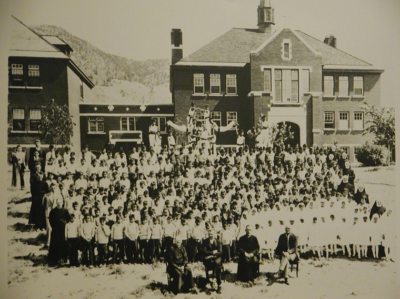 These were not small schools. Above is a photograph of the Kamloops Indian Residential School where the graves of 215 students who attended the school were discovered. With this as our backdrop, as Trustee Shuttleworth indicated that the Board received a number of requests to rename Ryerson Public School. We also received a number of messages indicating that we needed to do research to understand the positive contributions Ryerson has made to public education. When the renaming requests were received, the School Naming and Renaming Policy and Governance Procedure and Administrative Procedure were followed.
These were updated in January 2021, to reflect the new MYP and the current social context.
Once of the guiding principles of the policy is to “Consider equity, diversity and inclusion in the school community;”. The Governance Procedure details what is under the purview of Trustees, while the Administrative Procedure details staff responsibilities, and the two dovetail. In summary:
Renaming requests are submitted to the Director’s office, and the Chair and Director determine whether or not to bring forward a report to the Board. According to the Procedure, the renaming of a school shall be considered if: a) the current name constitutes a significant departure from generally-recognized standards of public behaviour which is seen to undermine the credibility, integrity or relevance of the HDSB’s contemporary values; or b) the current name was appropriated from a culture or community without the necessary recognition or awareness process.
In this case, a report was brought forward to initiate the renaming, and it was unanimously supported by the Board. Next steps include:
- Forming an ad hoc committee, involving staff, Trustees, and members of the school
- Notifying and seeking pubic input and ideas from the whole community (staff, students, community) which are narrowed down by the committee, and vetted to ensure the uphold the MYP and the criteria of the
- A short list of up to five, fully researched names, are submitted to the Board of Trustees for discussion and ultimate selection of one
This process for the current school under consideration, is to be wrapped up by the end of November 2021.
The discussion at the Board table was not an easy one, and certainly there are complexities. At the end of the day, the Board must uphold the commitments of the MYP. Its development reflects the ideas and values of thousands of people in the HDSB community. Now is our time to be true to those commitments, not only to the words, but to the actions that as a community we decided will make a positive impact on this and future generations.
During the discussion at the Board table, it was noted that the adjacent park has the same name, and as such, the Board wanted to alert you to the process that is going to be undertaken for the school.

 By Pepper Parr By Pepper Parr
July 9th, 2021
BURLINGTON, ON
The Standing Committee on Environment, Infrastructure and Community Services met earlier this week and almost swooned as they listened to Stephen Paquette talk about why the Ryerson school and the park adjacent to it should be renamed.
The Councillors and the two school board trustees who took part as delegations were like high school students listening to a rock star.
 Stephen Paquette. Paquette on the other hand was sensible and balanced.
Sure he took a strong position on the getting rid of the Ryerson name but he said he could live with statues of Sir John remaining providing there was a plaque beside the statue putting the man’s role in context.
Unfortunately many are not as sensible and balanced as Paquette.
He taught the Councillors some important lessons; one being the way we choose to elevate some people and create a statue and put it in a public place without a full understanding of the person. He seemed to be saying the statues were more adulation than realistic accounting of the person.
The fear I have is that we will rename the park and the school and then move on to something else forgetting what the real issue is – first making amends for the harm we created and then giving the Indigenous people what they deserve. Decent housing and water they can drink.
A number of years ago Gord Downie stood on a stage and implored the Prime Minister who was in the audience to take care of the Indigenous people. And how much has been done for those people since that time?
I look to Paquette being the person who keeps our feet to the flame and helps us get to the point where the members of the First Nation are true equals.
I was impressed with the man – he is an Elder serving as a staff consultant with the Halton District School Board. He is an excellent spokesperson for his people.
Joseph Boyden, wrote a book: The Orenda. It is a hard book to read on the relationship between the Jesuits who came to Canada to civilize the “savages”. There was painful cruelty on both sides. Boyden created significant controversy writing on Indigenous people. Boyden is primarily of Irish and Scottish ancestry. A number of Indigenous writers and researchers came forward to publicly state Boyden did not have the right to speak on behalf of any Indigenous community because he was not a First Nations citizen and ultimately not Indigenous.
We are going to be dogged with controversy on the question of how we atone for some time. Hopefully the plight of the Indigenous people gets improved while we squabble.
Salt with Pepper is the musings, reflections and opinions of the publisher of the Burlington Gazette, an online newspaper that was formed in 2010 and is a member of the National Newsmedia Council.

 By Staff By Staff
July 2nd, 2021
BURLINGTON, ON
After such an unusual year, local non-profit Bandology has some news that will hit all the right notes for keen young musicians. Their fifth annual Band Camp for teens will run a modified in-person, physically distanced camp this summer on July 12-16. A similar Band Camp Junior for kids ages 6-12 will run at the same time.
With the provincial government confirming that day camps may run this summer, Bandology has tweaked its usual concert band format to switch to handheld instruments instead. The potential to spread aerosol particles via blowing into instruments could be too risky, similar to school music programs which have not allowed blowing or singing this past year.
 A Bandology class in the Music Room at King’s Christian Collegiate in north Oakville However, the modified Band Camp will utilize a wide variety of handheld instruments, including drumline, ukulele, boomwhackers, bucket drumming and much more, all designed to keep kids interested and engaged. Plus, there’ll be music games and activities, plus special guests and performers. Above all, campers will have the opportunity to interact and hang out with other young musicians.
“This has been a tough year for everyone, but especially for kids used to hanging out in the music room,” said Lisa Michaels, co-founder of Bandology. “Social isolation and mental health are real issues that can be addressed by giving kids the chance to be together in a safe and welcoming environment.”
Bandology will observe all government protocols, including frequent hand washing and sanitization, physical distancing, mask indoors and small cohorts of campers. They will shift the majority of their programming outside, to reduce risk and extend opportunities for fresh air and play.
Parents can register their children online at bandology.ca. Band Camp V is for students in grades 7-12 while Band Camp Junior is for kids ages 6-12. Both camps run July 12-16 and are held at King’s Christian Collegiate in north Oakville. There is also a virtual option for those who would rather participate at a distance, with Band Camp Online running July 26-30.
Bandology provides other opportunities for young musicians to play, including the Play A Gig Online program, which gives kids and adults the chance to perform online, in either a live or pre-recorded format. Bandology also works to promote and advocate for the long-term value of music education.

 By Pepper Parr By Pepper Parr
June 30th, 2021
BURLINGTON, ON
The community battle to keep the current Robert Bateman High school functioning at some level within the community has been won.
 Bateman parents fought hard to keep the high school open. The parents with students attending the school were not able to keep the high school open – the bulk of the high school program got transferred to Nelson High School.
The Bateman parents were not wrong.
Ward 5 trustee Amy Collard, Ward 5 said “I have championed the idea of moving Gary Allan High School to the Bateman site since the decision to close Bateman was made in 2017, and I am very pleased to see the Board moving in this direction. The continued presence of a secondary school in southeast Burlington is good for the community.”
 Trustee Collard was consistent in her efforts over a five year period that the school site be retained for public use. Collard fought consistently to keep as much of the school operations in the community. At their June 2 meeting, Halton District School Board trustees approved a plan to relocate Gary Allan Learning Centre to Robert Bateman High School, both located in Burlington, and declare the remainder of the Robert Bateman High School facility surplus to its needs and to circulate it for purchase to other public agencies according to Ontario Regulation 444/98. This regulation sets out who can purchase or lease school property declared surplus and in what order expressions of interest are dealt.
As part of its disposition strategy of the former Robert Bateman High School property, the Board seeks to retain a long-term interest of approximately 45,000 square feet within the facility to accommodate Gary Allan Learning Centre, which provides adult, alternative and continuing education programs, and language instruction programs for newcomers, among others.
The plan to retain an interest in the facility is to ensure that the Board continues to maintain a visible and continued presence in the Southeast Burlington area, and continue offering and operating important educational programs within the community.
Through the Ontario Regulation 444/98 circulation process, public agencies will have the opportunity to submit their interest in retaining the remaining area of the facility of approximately 167,000 square feet to operate for their own uses in collaboration with the Board.
Public agencies include any government and/or educational entity that has jurisdiction within the area in which the school is located. The remaining Robert Bateman HS facility will be offered to prospective public agencies as a shared ownership, or as a long term lease back arrangement with the Board for up to 25 years on a cost recovery basis.
Burlington Marianne Meed Ward has had her eye on the property as well. Her ideas parallel those of Trustee Collard.
City Council is fully supportive of the City taking the important next step of formally submitting an expression of interest to purchase the Robert Bateman site now that the Halton District School Board (HDSB) has declared the site surplus.
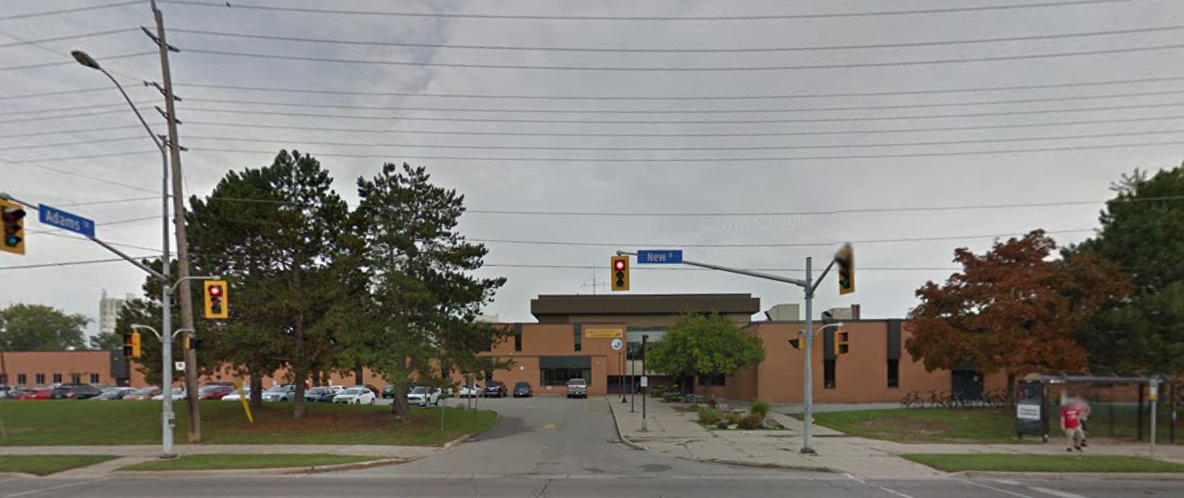 The building is in good shape, has a city owned swimming pool attached to it and a large sports field with a track at the rear. The City’s expression of interest will include the exploration of a partnership with Brock University to offer post-secondary programming on this site. The Burlington Economic Development Corporation has been the lead on that part of the file. Anita Cassidy has been working with Brock University on this.
In addition to exploring a relationship with Brock, the City also plans to partner with other institutions, ensuring that there is an adaptive reuse strategy for the site. This includes the Burlington Library relocating its Appleby Line branch to this location to develop a hub for learning and education.
Trustee Collard was very interested in having the school serve as a site where people new to Canada go for help in adjusting to how things are done in Ontario.
The Recreation Centre which is attached to the east side of the high school only adds to the outcome.
This acquisition would push forward key objectives laid out in the City of Burlington’s 25-year strategic plan. Key pillars of this Plan include making Burlington a city that grows through attracting talent, good jobs and economic opportunity to the community.
The Burlington Economic Development Corporation has been working with Brock University for some time. Setting them up at the Bateman site is a perfect fit.
 Former ward 6 Councillor Blair Lancaster as she signs the 20 year $1.3 million naming rights deal with Chris Haber lead partner of a Burlington law firm. Chris Glenn, Director of Parks and Recreation witnesses the “steal of a deal”. What we are seeing in this situation is much like the opening of the new high school and Library in Alton Village. The addition of a recreation centre resulted in a fully rounded community centre with a commercial driving school office on site. All it needed was a coffee shop and a dry cleaner to make it complete.
There is a very large sports field and track at the back of the school that will serve all the interests.
The issue will be to ensure that they do not give the “hub” a name that will come back to embarrass us all.
Naming rights were sold for the Alton set up – if naming rights are sold for Bateman location please ensure that the city gets a better deal. The price Haber paid for the naming rights was close to a steal.
Related news stories
Haber takes the naming rights
Collard fights to keep Bateman High school open.
The fight to keep Bateman open got a little dirty
Brock University decides they like Burlington better than Hamilton

 By Staff By Staff
June 29th, 2021
BURLINGTON, ON
The Ontario government is investing in a plan to counter Islamophobia and ensure classrooms are free from discrimination.
Those in the community who were raised in a different culture than what most of us are used to seeing are beginning to play a larger role in public life.
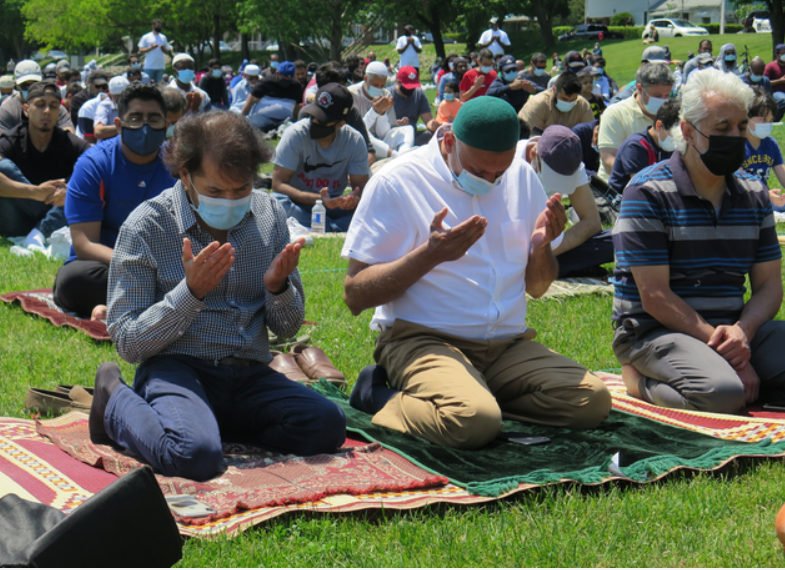 Muslims taking part in a public prayer event at Spencer Smith Park. The Muslim community recently held a Call to Payer on a Friday afternoon in Spencer Smith Park rather than at their mosque.
Few people in Burlington had ever witnessed such an event.
We now have a Muslim woman nominated as the Liberal candidate for the next provincial election.
We see a lot more woman wearing the hijab when they are out for a walk or in the supermarkets. We are also seeing different food offerings on the shelves.
We human being are not very good at adapting to change. The kids get it – their parents have a more difficult time.
As part of the Safe Return to Class fund, Ontario’s government is providing $225,000 to the Muslim Association of Canada to create digital resources for educators, students and parents to raise awareness about Islamophobia. These resources will provide information about Islamic practices, values and misconceptions, root causes of Islamophobia and ways to help end Islamophobia, racism and discrimination.
Ontario is also providing $75,000 to the National Council of Canadian Muslims to facilitate outreach and engagement with Muslim parents and families, with a focus on newcomer communities. These engagements will provide information on school supports and will provide culturally relevant resources to enhance well-being for families and help Muslim students prepare for the return to school in September.
 The Muslim community is reaching out to the people of Burlington – the city now needs to learn to hear what they are saying. According to the most up to date data from Statistics Canada, hate crimes have been on the rise in Canada, with a nine per cent increase in anti-Muslim attacks in 2019, when compared to the previous year. Tragic and disturbing reports and incidents across Canada and the world over the past years underscore the need for action.
“It is unacceptable that many Muslim students continue to face discrimination in our schools, on our playgrounds and in communities across this country,” said Minister of Education Stephen Lecce. “That is why we are investing and partnering with community leaders — who are leading this effort— to counter racism and better support Ontario’s Muslim students and their families.

 By Staff By Staff
June 28th, 2021
BURLINGTON, ON
It has been a long, long, long 18+ months; with vaccinations on the rise and covid cases on the decline, things are starting to get back to some sort of normalcy. But… we still have a long way to go and while summer fast approaches, the reality is there is still a lot we don’t know and much to contend with.
The folks at Peachey Counselling Services are putting on a free Coping with Covid workshop July 7th from 6:30 to 8 pm via Zoom.
 Stephanie Peachey, a Registered Social Worker and founder of the Counselling and Family Support Service will be delivering part of the free workshop July 7th During the live zoom event they will break down how to cope with stress, anxiety and burnout. They will pass along some tips and set out some strategies to help build resiliency so you can have the best summer possible.
Topics Discussed
What You May Be Feeling: From frustration to fear, to anxiety or burnout. We’ll talk it out.
Under Pressure: Do you NOT want things to go back to pre-pandemic days? Do you feel pressured to let go of some of the things that you liked about being in lockdown?
Getting Prepared for Uncertainty: If there is anything we learned, especially in the last several months, we don’t know what to expect or plan for…so we’ll work on being prepared to handle that kind of uncertainty.
Building Resiliency: We’ll share all sorts of tips and strategies to help you develop the coping skills you will need to build resiliency so you can have the best summer possible.
This workshop is being facilitated by Stefanie Peachey, Registered Social Worker and owner of Peachey Counselling and Family Support, and Chris Martin, Registered Psychotherapist and member of Peachey Counselling and Family Support.
Their office is on the Pearl/Pine side of Village Square; 414 Pearl Street Unit 11 Village Square Burlington ON L7R 2N1 Situated on the 2nd floor
To Register email their office at: info@peacheycounselling.ca

 By Pepper Parr By Pepper Parr
June 25th, 2021
BURLINGTON, ON
It has been a very difficult year for school boards across the province.
 Most of the students can’t wait to get back to their classrooms, Senior staff at the Halton District School Board “expect” students to return to class in September but no one is able to say with certainty that they will open.
Everything depends on how many people have been vaccinated and if the new infection levels decline.
And – that one of the variants does not get past the defences we have in place.
At the last Board meeting until September the public got to hear the totals on the budget that had been approved.
The Operating budget came in at $815,389,709
The Capital budget came in at $87,383,860
.

 By Staff By Staff
June 21st, 2021
BURLINGTON, ON
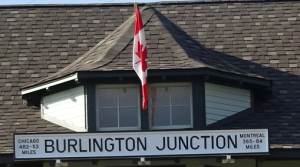 Friends of Freeman Station, the not-for-profit charity in Burlington (Ontario) run by volunteers working together to preserve a 1906 Grand Trunk Railway Station, have added a caboose and a box car to their rolling stock. Friends of Freeman Station, the not-for-profit charity in Burlington (Ontario) run by volunteers working together to preserve a 1906 Grand Trunk Railway Station, have added a caboose and a box car to their rolling stock.
The boxcar is believed to have been in service when Burlington farmers would take their produce down to the station to be loaded on to trains and delivered to Toronto and Montreal.
First to arrive was the Boxcar – Canadian Pacific #404109. Weighing in at LT WT 43,000, it is green in colour with white lettering.
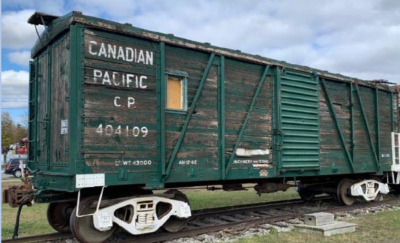 Boxcar – Canadian Pacific # 404109. The wooden walls are in excellent shape as is the steel roof.
Then CN caboose #78188 arrived. Built in October 1929, records indicate it is AAR class NE Caboose type M930 built of wood by CN Transcona.
Until recently both railcars were on display at Memory Junction in Brighton Ontario, a railway park for visitors at the site of the old Brighton Railway Station.
 CN caboose # 78188 Brighton is located between Cobourg and Trenton and sits on the CN and CP lines originally laid in the 1850s and are still used daily.
Memory Junction had to close in 2020 due to various reasons and all the displays were removed at auction in October 2020.
Prior to Brighton – these cars were on display in Trenton Ontario. Before that, the caboose was displayed at Doon Pioneer Village in Kitchener in the 1990s.
The cars will be placed on the new track that has been laid immediately to the north/west side of the Freeman Station building.
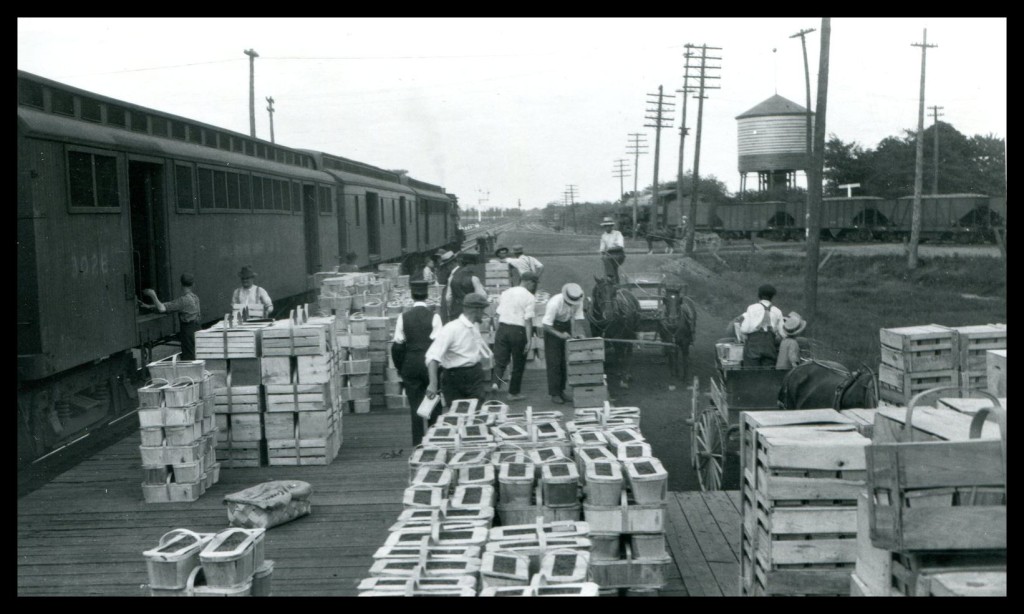 Brought into the Freeman Station by a team of horses pulling a wagon to be loaded onto boxcars for delivery to Toronto and Montreal. Some of the better produce was transported to Europe. After some work is done inside and out the cars will be open to the public to visit. These cars give the charity more much needed room to display the artifacts and stories they have accumulated.
Once the COVID restrictions are lifted visitors can see the city’s newest tourist attraction joining the Joseph Brant Museum, Ireland House and the Pier – must see Burlington locations.
Funding for the acquisition, transport and set up of the cars was provided by member donations as well as a large donation from one of their sponsors.

 By Staff By Staff
June 18th, 2021
BURLINGTON, ON
I recently received correspondence from the Chair of the Board of the Halton District School Board (HDSB) notifying me that the Trustees, at their June 16, 2021 meeting, approved a motion to rename Ryerson Public School on Woodview Road in Burlington in accordance with the Board’s Naming and Renaming Schools Policy and Governance Procedure.
A city-owned park adjacent to the school also bears the Ryerson name.
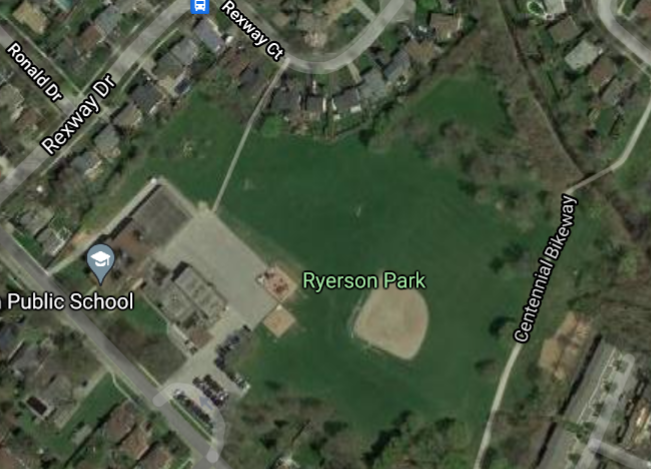 The Mayor is now ashamed of the man who created the public education system that has served everyone very well. 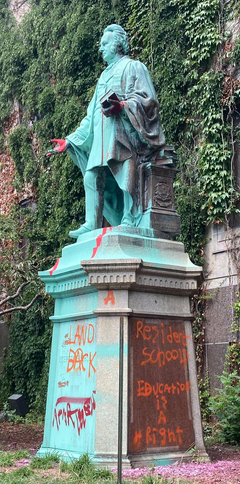 The statue to commemorate the man who created the public school system in Ontario was first defaced and then toppled Ryerson Public School and adjacent Ryerson Park are named after Egerton Ryerson for his contributions to the Ontario education system, however, Ryerson was also instrumental in the design of Canada’s Residential School system. In 2015, the Truth and Reconciliation Commission of Canada concluded this assimilation amounted to the genocide of Indigenous peoples.
The City of Burlington is committed to equity, diversity and inclusion, and the names we choose for our municipal properties must reflect that commitment – both going forward, and in retrospect. As part of that commitment, Burlington City Council recently unanimously endorsed the Halton Equity, Diversity and Inclusion Charter produced by the Halton Equity and Diversity Roundtable. We have also recently updated our naming policies to ensure equity, diversity and inclusion is integrated in all our asset naming.
There have been growing calls to remove Ryerson’s name from public buildings and institutions, including Ryerson University in Toronto, where a report on the matter is expected to come before their president and board of directors this fall.
I support the change the HDSB is making and the reasons behind it.
 Mayor Marianne Meed Ward As part of our continued commitment to equity, diversity and inclusion, I am working with City of Burlington staff to bring forward a report to Committee and City Council in July 2021 recommending removing the Ryerson name from our park and embarking on the council-approved naming process. We expect this process to be complete by November 2021. We will keep you updated on this process and opportunities for members of the public, including the HDSB, to provide input.
Our Indigenous community needs to enjoy our parks and public spaces without a reminder of one of the architects of the Residential School system and the legacy of harm it created for their people. Renaming our city park is one step we can take toward reconciliation with our Indigenous residents.

 By Staff By Staff
June 17th, 2021
BURLINGTON, ON
At the June 16, 2021 meeting of the Halton District School Board, Trustees unanimously approved a motion to rename Ryerson Public School on Woodview Road in Burlington in accordance with the Board’s Naming and Renaming Schools Policy and Governance Procedure.
 Egerton Ryerson statue The renaming process will begin in September 2021 to ensure the parent/guardian, student and broader community has the opportunity to provide their input. The process to rename the school will be completed by the end of November 2021. The current exterior school sign will be covered until a new name is chosen. Information and signage will also be posted to indicate a renaming process will take place in Fall 2021.
As part of the Board motion, the Chair of the Board will also send a letter to the Mayor of Burlington to inform her of the initiation of the HDSB process to rename the school, as the community park adjacent to the school bears the same name.
Ryerson Public School was named after Egerton Ryerson for his contributions to the Ontario education system, however, Ryerson was also instrumental to the design of Canada’s residential school system. In 2015, the Truth and Reconciliation Commission of Canada concluded this assimilation amounted to the genocide of Indigenous people.
There have been growing calls to remove Ryerson’s name from public buildings and institutions and the HDSB has received formal requests to remove Ryerson’s name from the school. At their June 16, 2021 meeting, Trustees also heard a delegation from a Ryerson Public School parent in support of renaming the school.
As part of the HDSB’s Multi-Year Strategic Plan 2020-2024, the Board has committed to champion supportive and inclusive practices, and to promote knowledge and understanding of Indigenous perspectives and realities. One of the first steps taken is to assess how the HDSB can raise awareness.
“As Trustees, we need to lead by example and have the courage to approach these difficult conversations,” says Chair Andréa Grebenc. “As years have gone by and truths have been uncovered, we have a responsibility, in collaboration with our staff and communities, to reevaluate past decisions and address accordingly.
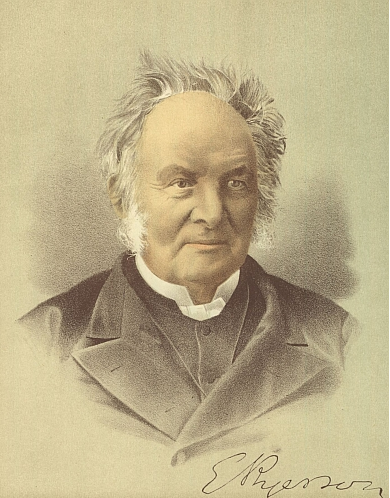 Portrait of Egerton Ryerson “The perspectives of the diverse communities of Halton must be valued and honoured. Indigenous students, staff and the broader community should be able to enter a school without being harmed by the HDSB upholding the name of a person that has contributed to genocide.”
Egerton Ryerson did more than contribute, he created the public school system we have today. Erasing history doesn’t mean it disappears – all we have done is hide it.
Ryerson was reported to have “done more than any other man of his day for the cause of public instruction in Ontario.”

 By Eva Thaler By Eva Thaler
June 16th, 2021
BURLINGTON, ON
Students have some favorite places to visit to ease their stress after a long, tiring day at school. Know their favorite places in Burlington.
Burlington is among the places that students choose to study. There are a lot of schools that students can choose from. It is favorite among parents and students because of the suitable environment it has plus the good quality of education its schools provide. Being in a top-notch school, university or college can bring pressure and stress to any student. It is normal to be given tons of schoolwork in these wonderful schools. You would sometimes wish you could ask someone to help you and say ‘please
write a paper for meessay helper online
It is a good thing that you can find essay helper online these days. There are websites like https://writemyessayforme.cheap/ and many others that you can order essays from. This will give you the chance to be eased from doing tons of written work for the school. Through these student-help websites, you can take a breather and relax a bit.
Students are not just for schoolwork. They should also have the time for themselves to relax, rest and enjoy life. Burlington may have the best schools around, but it also has tons of places that students love to visit.
Top Places in Burlington for Students
Mapleview Shopping Centre
This premier shopping centre in southern Ontario is among the favorites of students with shopping, dining, movies, and more. When they want to unwind and simply enjoy the company of friends, this is their usual destination. It has establishments where they can eat, play, shop, and enjoy. And of course, shopping is always among the favorite pastimes for young people.
 One of the best outdoor locations in the city. Royal Botanical Gardens
Not all may love plants and flowers, but this garden is a favorite place for students. It is because it is relaxing and quiet. The plants, trees, and flowers will free your eyes and mind from the stress and pressure that you get from school. It will relax your body and brain and simply give you the time to re-energize. Besides, this is a national historic site in Canada and everyone wants to visit this place because of its beauty.
Mount Nemo Conservation Area
Students who love adventure often visit the Mount Nemo Conservation Area. Here, they can walk down the trail, jog, climb and simply explore the beautiful mountain tracks. Those who wish for an outdoor and physical activity to do will enjoy going to this place.
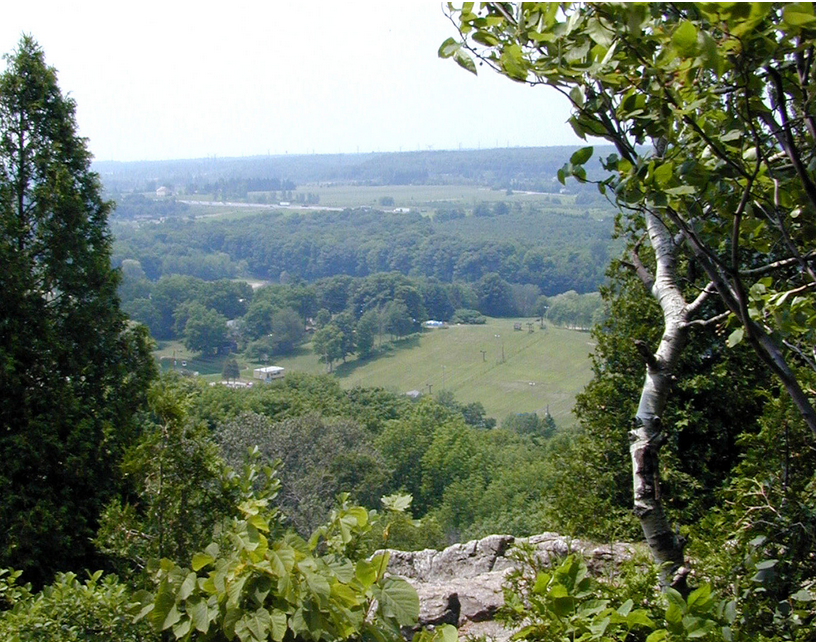 From the top of Mt Nemo you can see the CN Tower on a good day – everyday you can say rural Burlington spread out before you. On a spectacular day you might find a rock climber popping up in front of you as the scale the heights. Art Gallery of Burlington
Students who love arts are the ones who frequently visit this place. Art museums can be informative and inspirational. Those who are thinking of pursuing a career in the arts will surely enjoy visiting an art museum like the Art Gallery of Burlington.
Downtown Burlington
Students who do not have a specific activity or place in mind would just go downtown. This is where they can find many activities to do and establishments to visit. You can go walking on the streets where you can see historic buildings. There are also hotels, churches, and establishments that will amaze your eyes.
Bars and Lounges
Students also love the nightlife. Those who love music, food, drinks, and the company of friends enjoy going to bars and lounges. Burlington has tons of these and students can easily pick their favorites.
Stonehaven Farms
Those who love fruit picking or seeing lovely plantations of vegetables go to Stonehaven Farms often. Students that cook a lot or those who are into agriculture enjoy visits to these farms. This farm has been around since 1904. Its bounty of fresh produce is well-maintained and has been providing the people of Burlington nature’s products all year round. This place offers clean, and relaxing air which will help students relax and simply enjoy nature.
 Popular waterhole – yards from Spencer Smith Park and the edge of Lake Ontario Roaming around for Restaurants
There are tons of restaurants in Burlington. From the ones that sell cheap hotdogs on buns or stick to the fine dining restaurants, students explore and get to taste the delicacies being served in the many dining establishments around Burlington. Students who have free time usually go out and dine in with friends or family. There are various cuisines to choose from, giving students a lot of options.
Lowville Park
This has been a good summer getaway for many students of Burlington. You can do fishing, basking in the lake, walking, picnicking, jogging and a lot more. This place is not only for friends but also for the entire family.
When the students get their time off from school, these are the places they usually go to in Burlington. This place offers tons of activities that students of different preferences will enjoy. There will always be a perfect place for every student of Burlington. This is among the reasons even international students would love to study here. It is not just the schools that they want to enjoy but also the entirety and beauty of Burlington.

 By Staff By Staff
June 5, 2021
BURLINGTON, ON
Rainbow Crosswalk are now part of the Burlington streetscape.
The first was put in place across Lakeshore at Burlington Street, at a cost of $10,000.
Public response was very positive and there was appetite for other Rainbow crosswalks.
The city did a survey asking people where they thought the next cross walk should be.
The response to the survey was very high – the preferred location surprising.
Citizens chose to have the next Rainbow Crosswalk on Fairview, near Drury which would be basically in front of the Halton District Catholic School Board.

The report on the survey and the results will be going to Community Planning, Regulation and Mobility Committee on Tuesday June 8th beginning at 9:30 a.m.
It will be interesting to see if there are any delegations.
The Halton District Catholic School Board chose recently to not permit the raising of Rainbow flags at Catholic schools.

 By Staff By Staff
June 4th, 2021
BURLINGTON, ON
Those men and women who drive the school buses have a sense of humour. And like everyone else they have learned to pivot – rather well.
 School bus company pivots to reward drivers. They weren’t able to hold their annual Awards Banquet – they came up with a different idea.
This year they are holding a drive-through BBQ for the drivers and they are holding a charity dunk-the-staff-and-managers event for the drivers.
 Dunking senior management Every driver has been given a form to indicate which management and staff they want to dunk.
The drivers will pay $2 a ball or 3 balls for $5.
100% of the funds will be going to Food for Kids Halton.
We will get back to you on the where of this event.

|
|
 By Mark Gillies
By Mark Gillies


















 No doubt about it, everyone at the time believed this was a “WIN-WIN” situation. Spencer Smith’s story was a perfect example of one that seemed to have a happy ending.
No doubt about it, everyone at the time believed this was a “WIN-WIN” situation. Spencer Smith’s story was a perfect example of one that seemed to have a happy ending.
 This became an economic issue more than anything else. It was strictly a case of supply and demand. Most of these organizations were faced with a huge demand. They had great difficulty in meeting the demand by farmers and governments in Canada and Australia. It was stated at one time that there were 10 applications for every child. So what were they going to do? The answer was simple. Start rounding up any child who potentially was wayward and lived in the area that was to be scoured for recruits. Overly simplified, absolutely, but not by much.
This became an economic issue more than anything else. It was strictly a case of supply and demand. Most of these organizations were faced with a huge demand. They had great difficulty in meeting the demand by farmers and governments in Canada and Australia. It was stated at one time that there were 10 applications for every child. So what were they going to do? The answer was simple. Start rounding up any child who potentially was wayward and lived in the area that was to be scoured for recruits. Overly simplified, absolutely, but not by much.
 They were forced to live in exclusion on the farmer’s property, and not interact with the farmer’s own children or have any friends of their own. They were not loved or nurtured in any way. We know that they were constantly tormented and bullied by other children at local schools, and even adults participated in this human degradation of these children. We know that many just eventually disappeared. Where you ask?
They were forced to live in exclusion on the farmer’s property, and not interact with the farmer’s own children or have any friends of their own. They were not loved or nurtured in any way. We know that they were constantly tormented and bullied by other children at local schools, and even adults participated in this human degradation of these children. We know that many just eventually disappeared. Where you ask? Albert had just arrived from England with many other British Home children and they all disembarked at Halifax from the ship Albertic on March 17, 1930.
Albert had just arrived from England with many other British Home children and they all disembarked at Halifax from the ship Albertic on March 17, 1930. Where do we stand? Sadly, and unfortunately, the Canadian Government has essentially taken the position that this isn’t really a big deal, and no apology is warranted or forthcoming, even though they backed and encouraged this form of child slavery and abuse under the guise of helping disadvantaged children. Personally, I think that Jason Kenney the Cabinet Minister responsible for these remarks was not that well informed on the situation when confronted with the apology question, and consequently brushed it off as unimportant. I encourage you to contact Burlington’s local Federal Member of Parliament, Mr. Mike Wallace, who is a very decent man, and please voice your concern. I would like to think that Mike can champion this cause and help us get this apology from the Canadian Government. It’s long overdue, and it’s the right thing to do.
Where do we stand? Sadly, and unfortunately, the Canadian Government has essentially taken the position that this isn’t really a big deal, and no apology is warranted or forthcoming, even though they backed and encouraged this form of child slavery and abuse under the guise of helping disadvantaged children. Personally, I think that Jason Kenney the Cabinet Minister responsible for these remarks was not that well informed on the situation when confronted with the apology question, and consequently brushed it off as unimportant. I encourage you to contact Burlington’s local Federal Member of Parliament, Mr. Mike Wallace, who is a very decent man, and please voice your concern. I would like to think that Mike can champion this cause and help us get this apology from the Canadian Government. It’s long overdue, and it’s the right thing to do.





























 By Pepper Parr
By Pepper Parr


 By Staff
By Staff

 “It was a privilege to be the first Vaccination Centre in Halton Region and to be part of the largest immunization rollout in a generation,” said Denise Hardenne, President & CEO, Halton Healthcare. “By August 15 we expect to have administered 200,000 vaccines at the OTMH Vaccination Centre. With community clinics now well established and the demand for vaccines decreasing, the closing of hospital vaccination centres will provide us with the opportunity to focus on our recovery plan. I couldn’t be more proud of the efforts of our staff and physicians for their dedication and tremendous efforts in the fight against COVID-19.”
“It was a privilege to be the first Vaccination Centre in Halton Region and to be part of the largest immunization rollout in a generation,” said Denise Hardenne, President & CEO, Halton Healthcare. “By August 15 we expect to have administered 200,000 vaccines at the OTMH Vaccination Centre. With community clinics now well established and the demand for vaccines decreasing, the closing of hospital vaccination centres will provide us with the opportunity to focus on our recovery plan. I couldn’t be more proud of the efforts of our staff and physicians for their dedication and tremendous efforts in the fight against COVID-19.” By Staff
By Staff





















 Friends of Freeman Station, the not-for-profit charity in Burlington (Ontario) run by volunteers working together to preserve a 1906 Grand Trunk Railway Station, have added a caboose and a box car to their rolling stock.
Friends of Freeman Station, the not-for-profit charity in Burlington (Ontario) run by volunteers working together to preserve a 1906 Grand Trunk Railway Station, have added a caboose and a box car to their rolling stock.

















